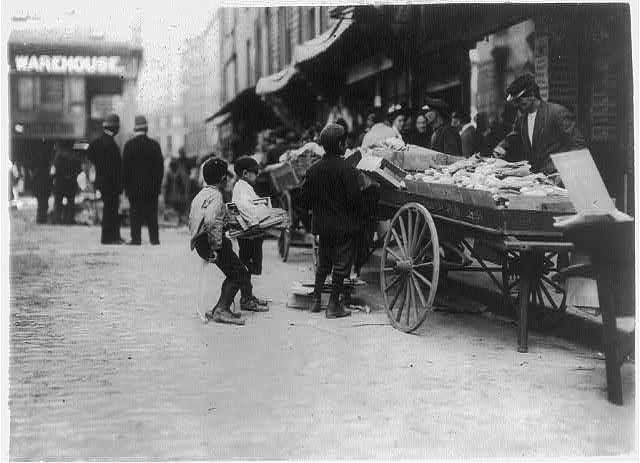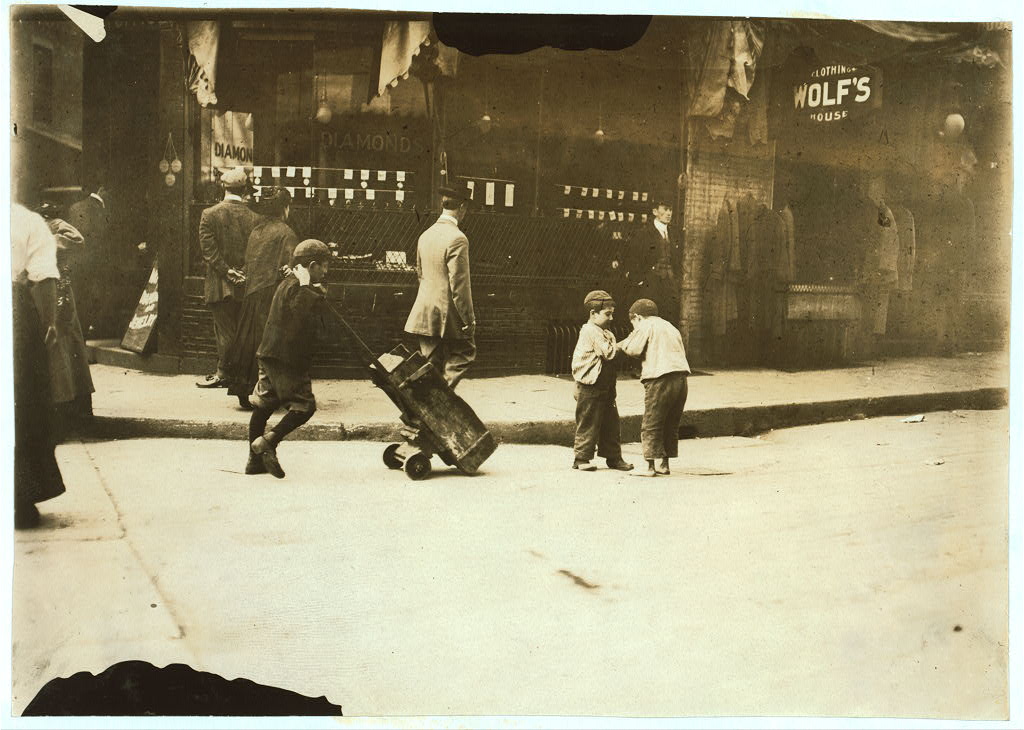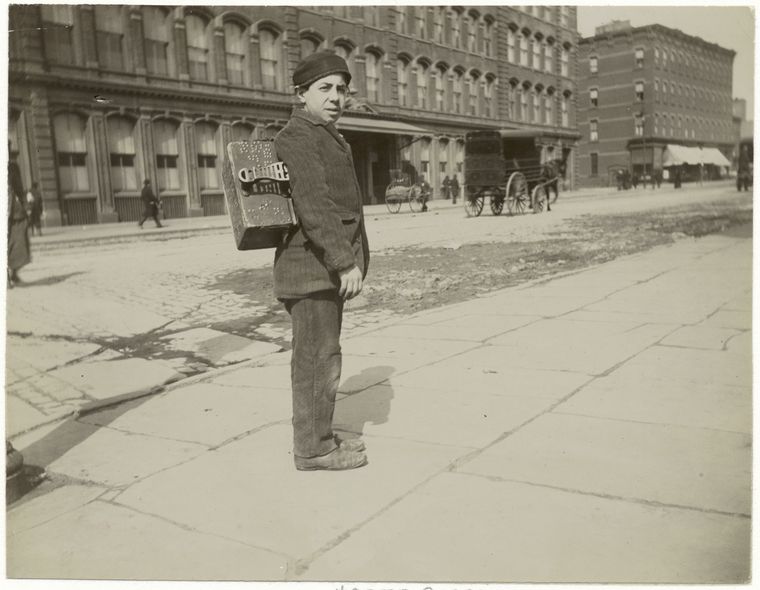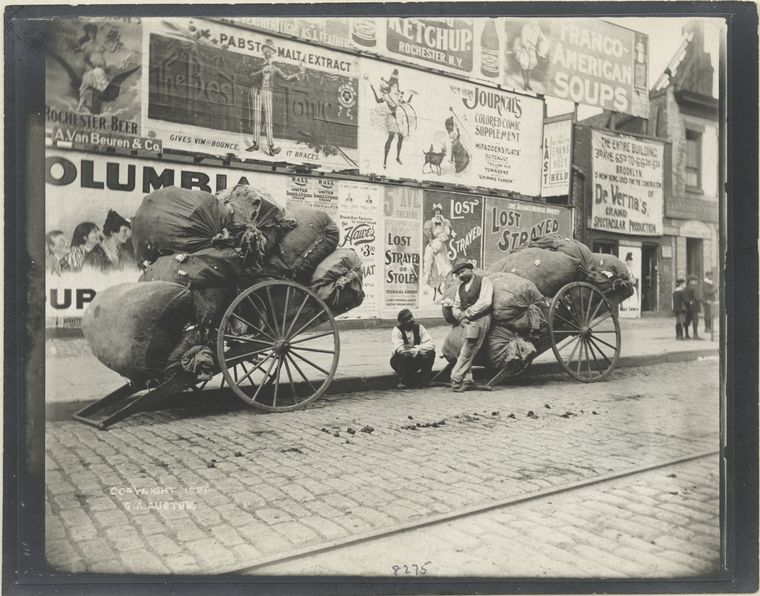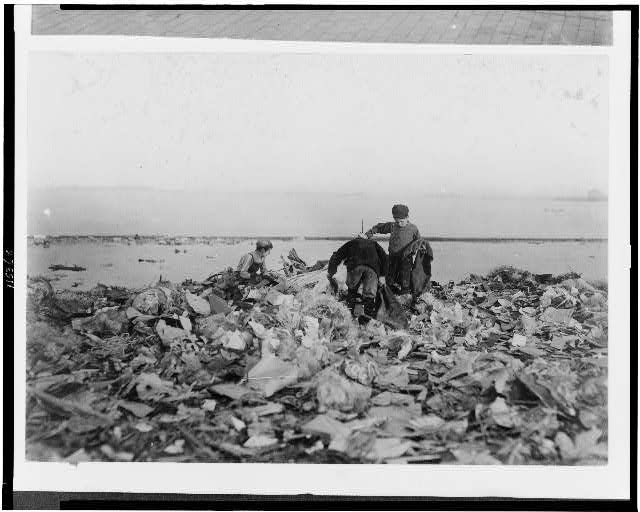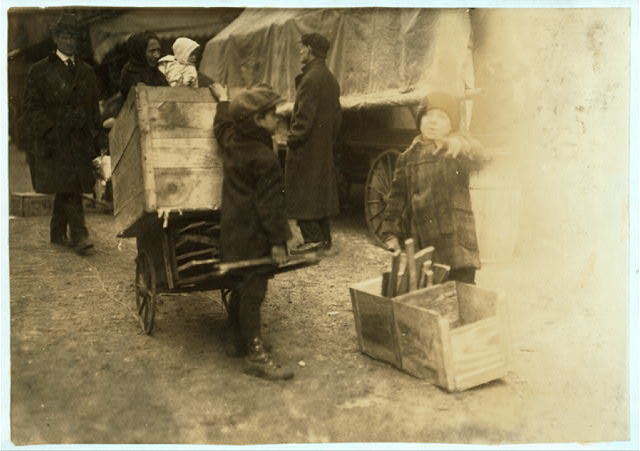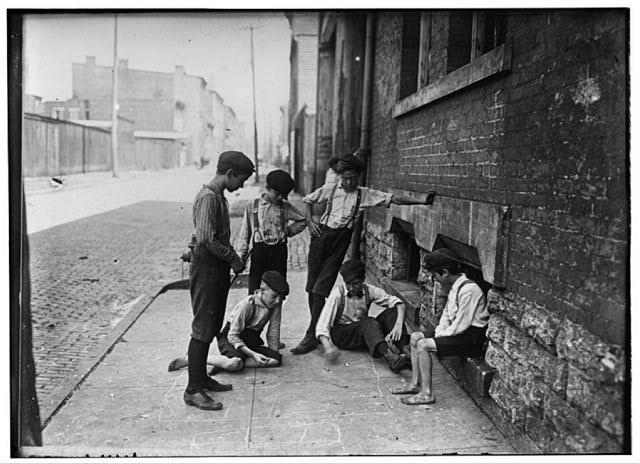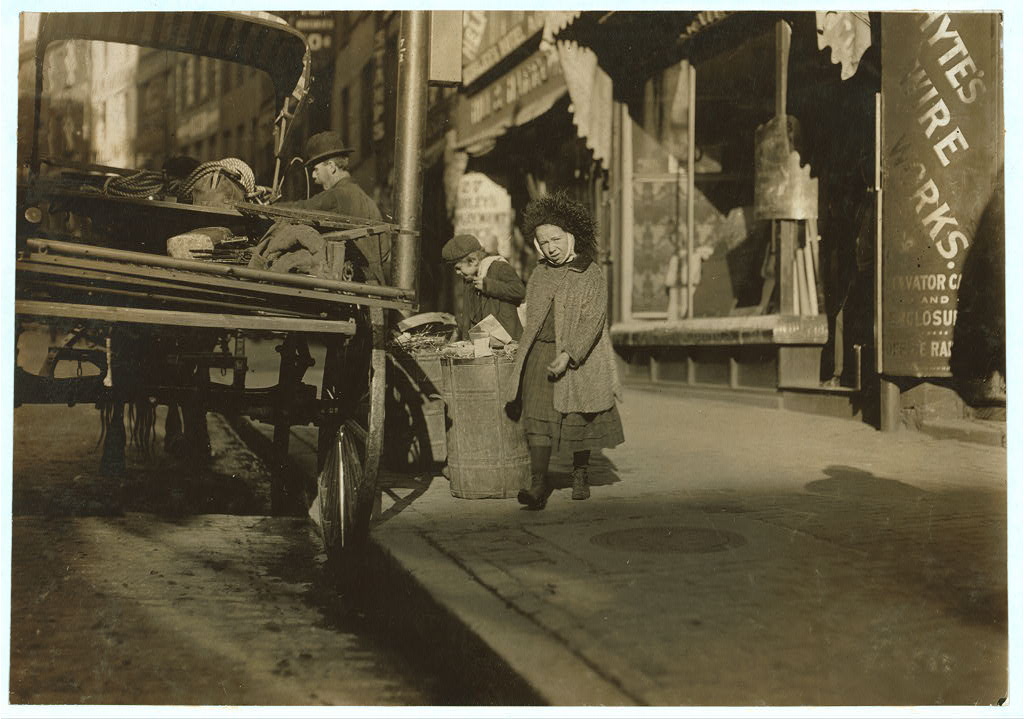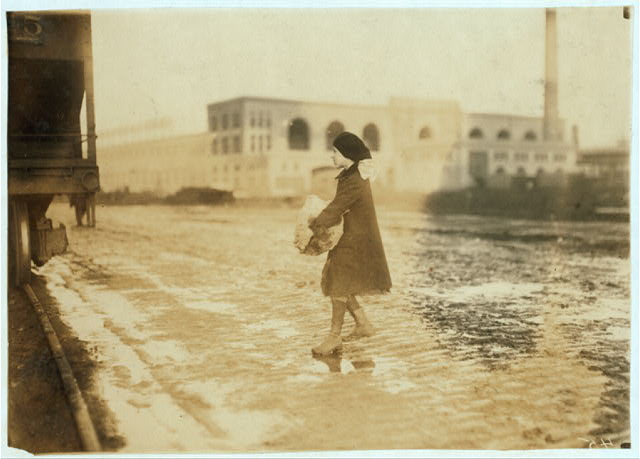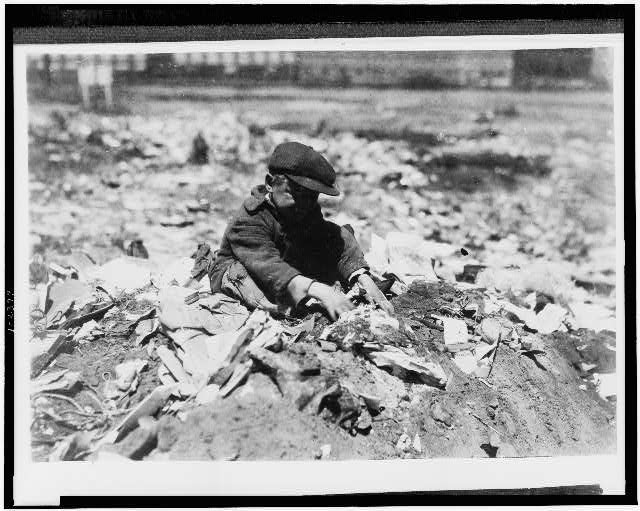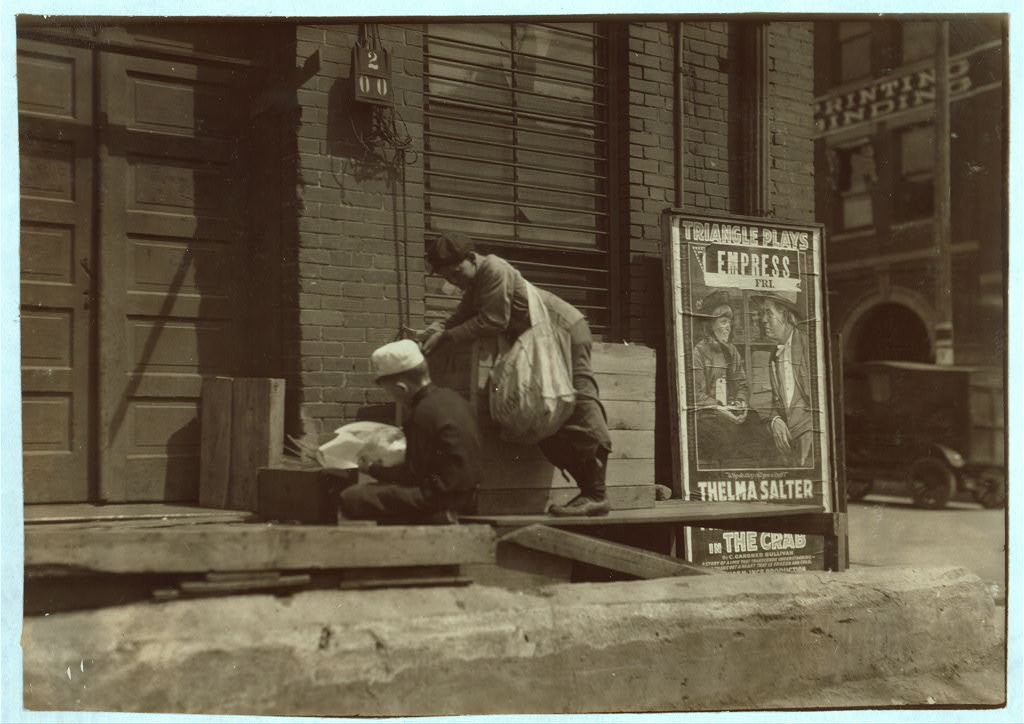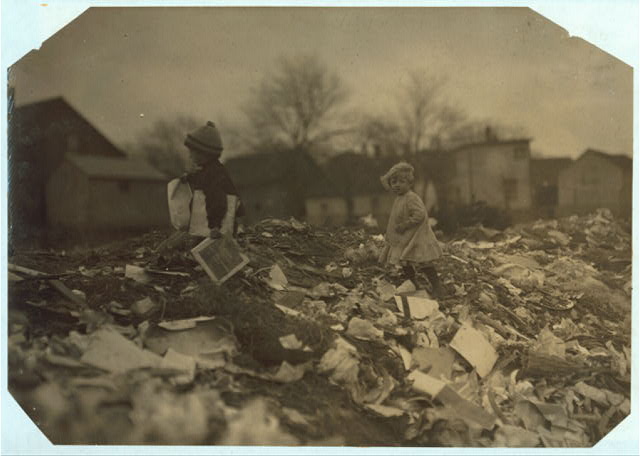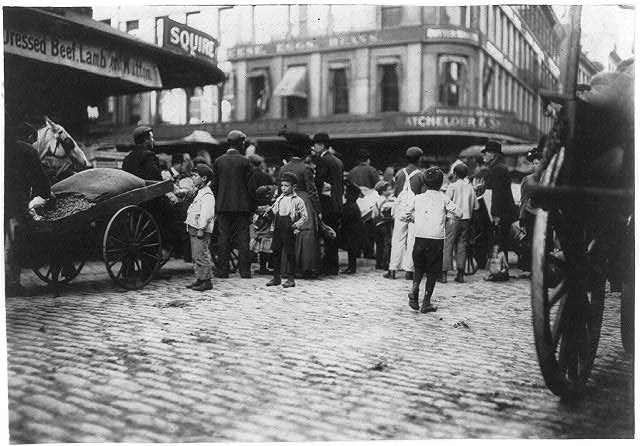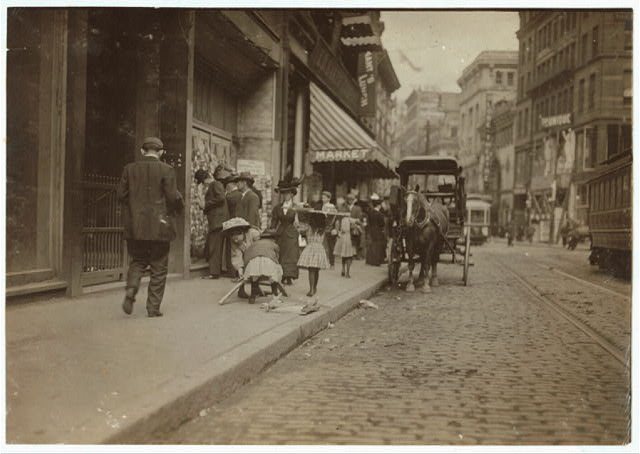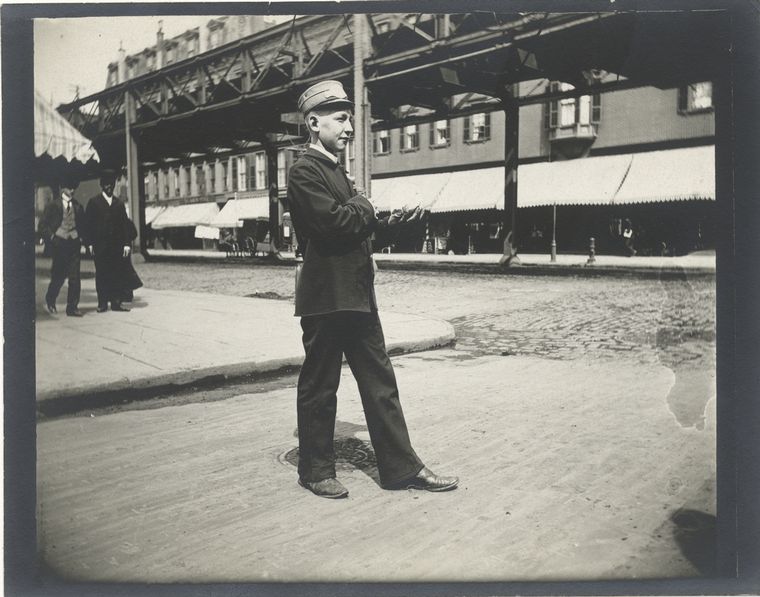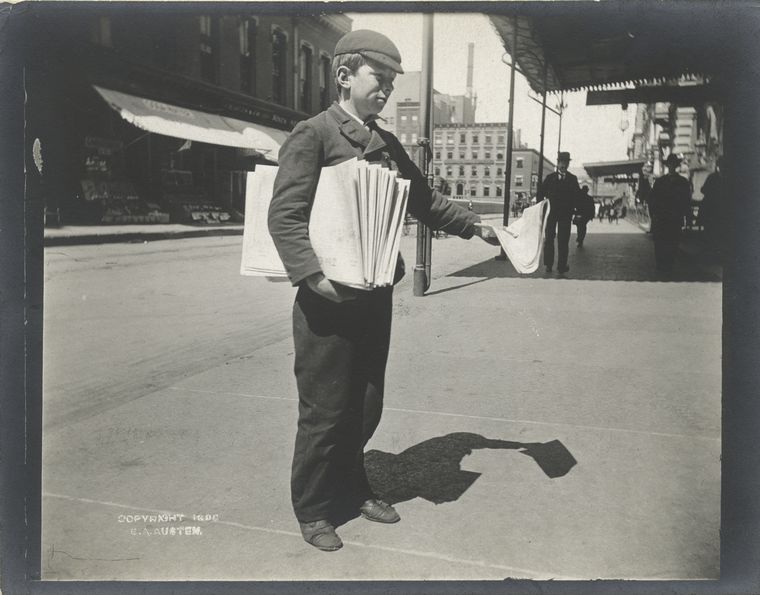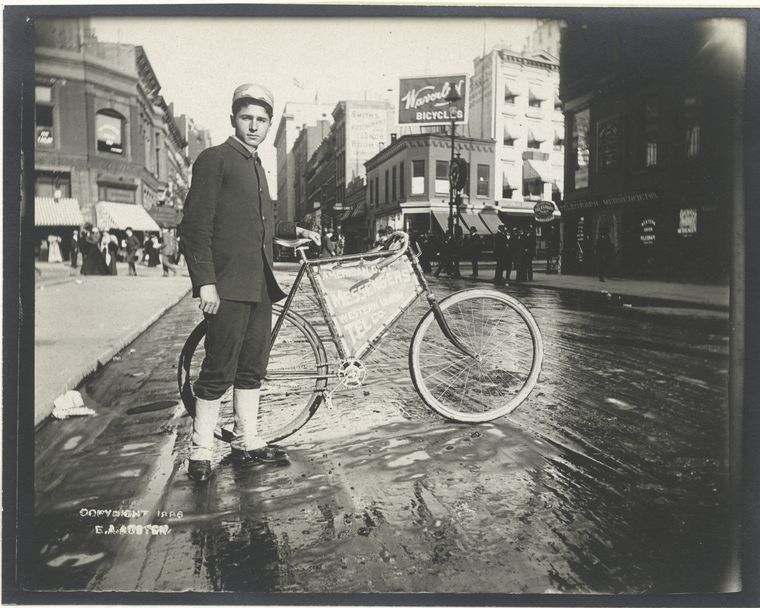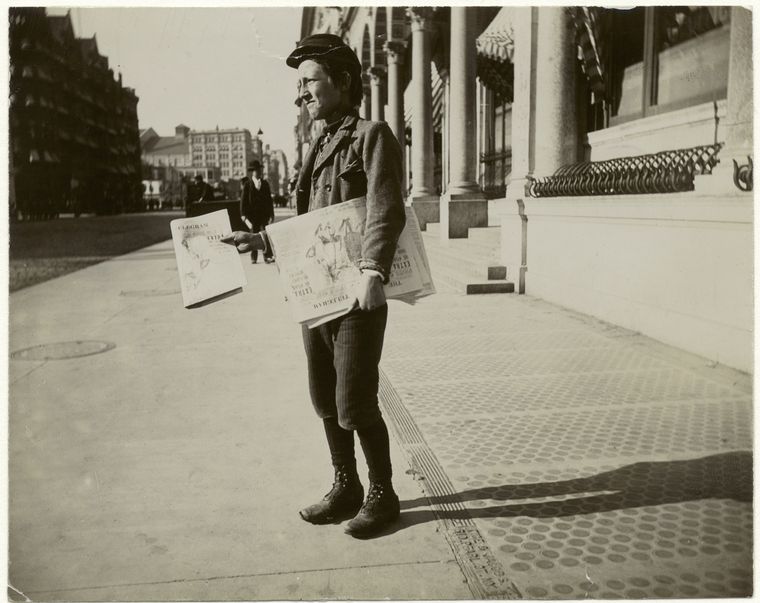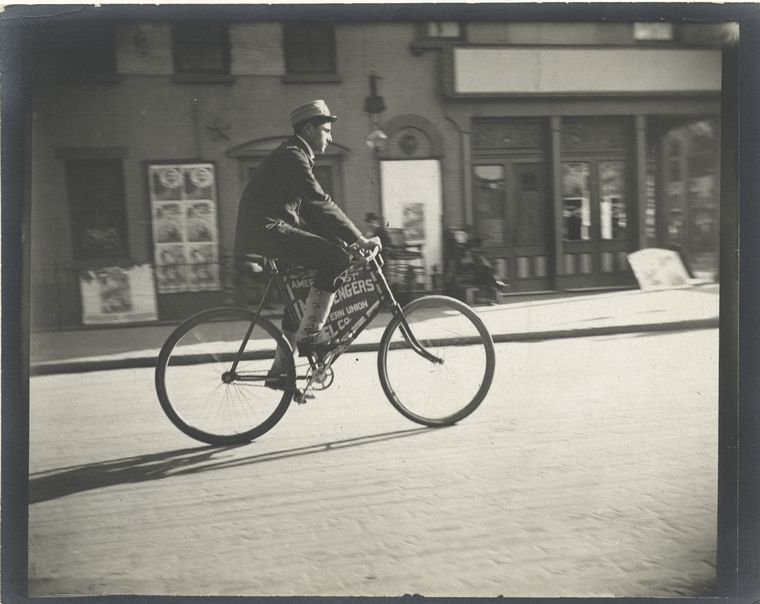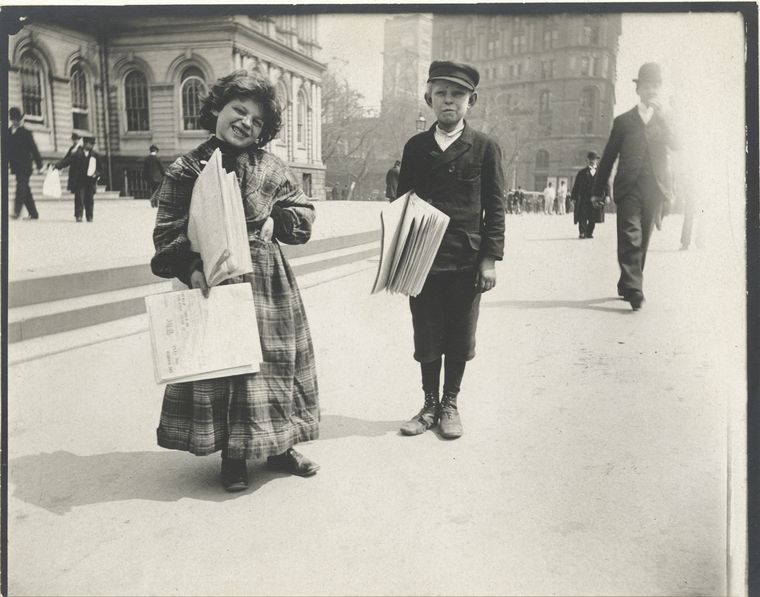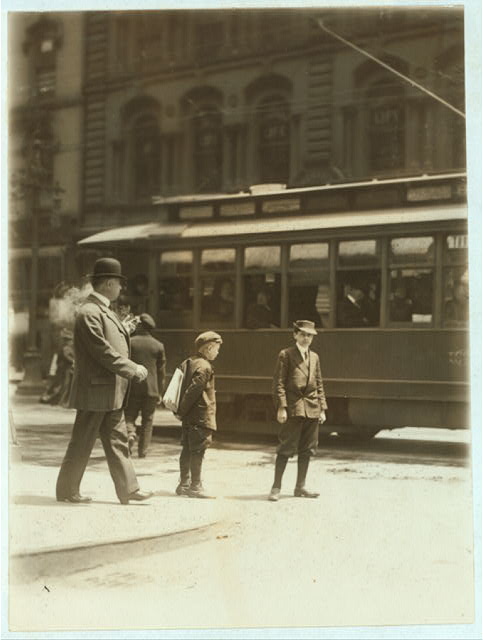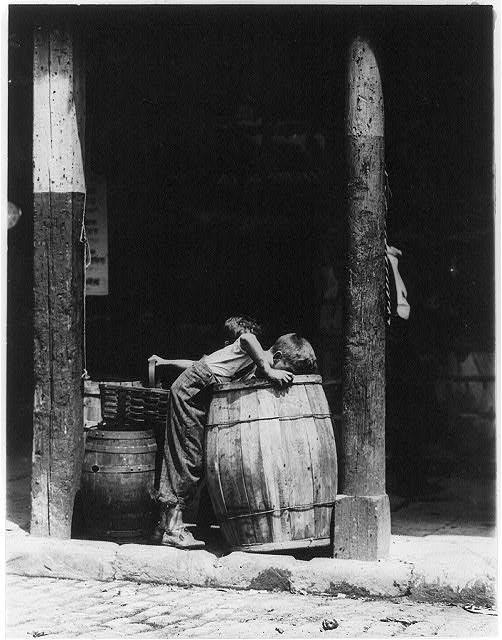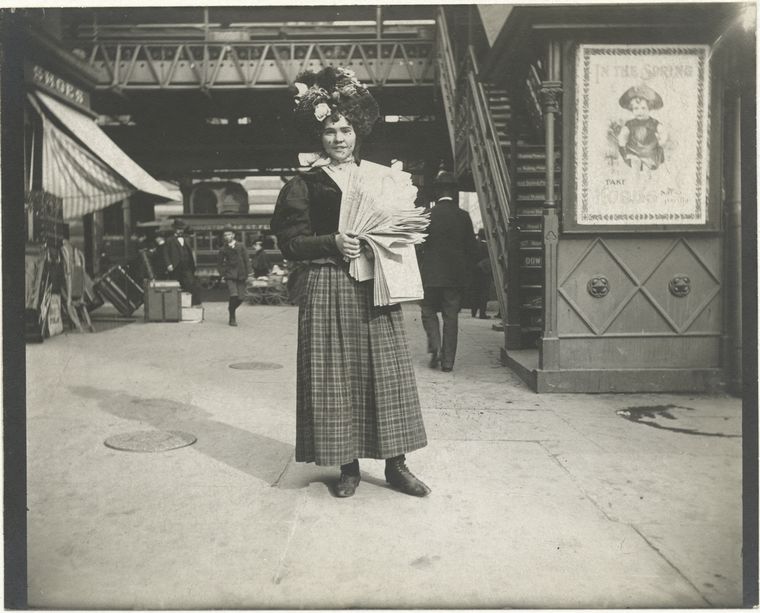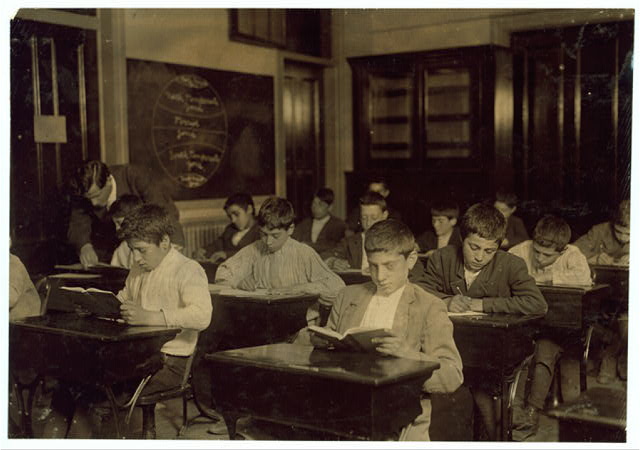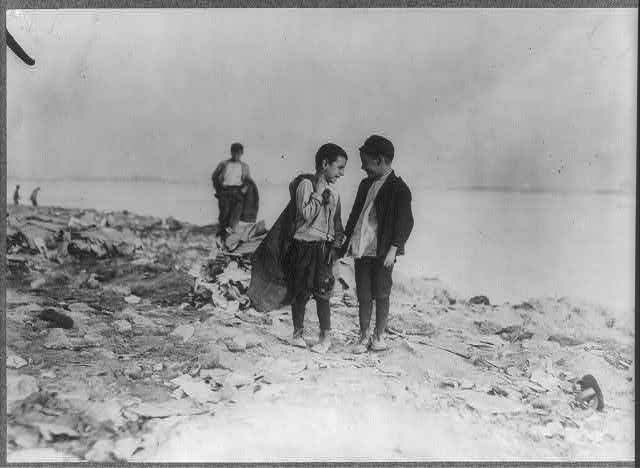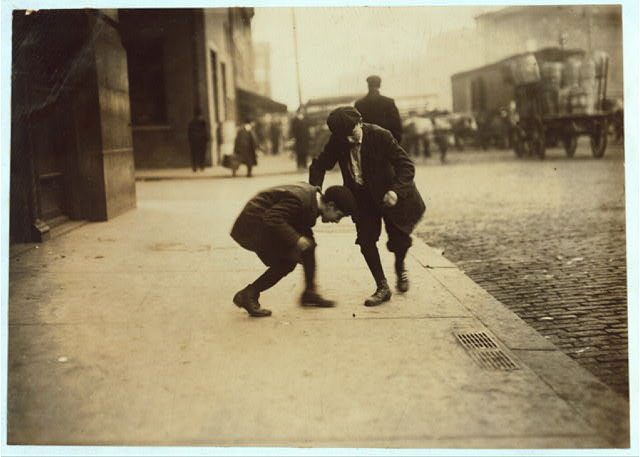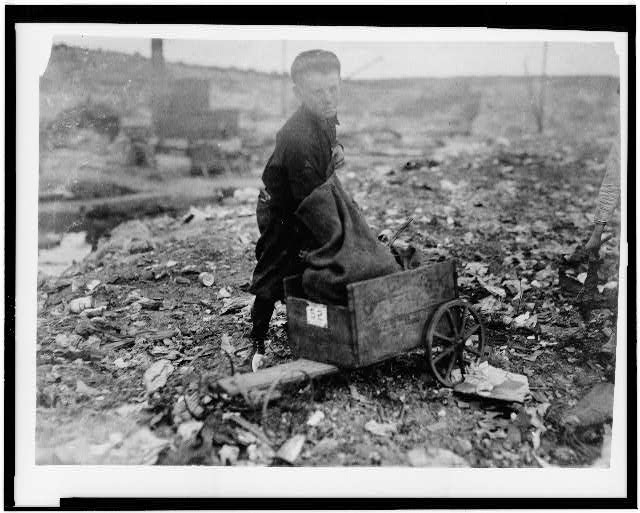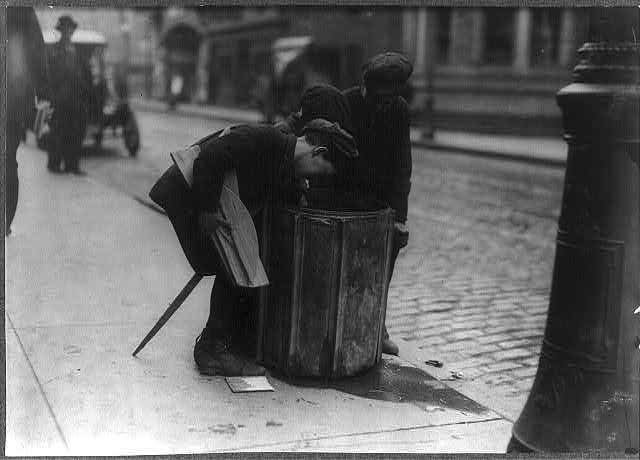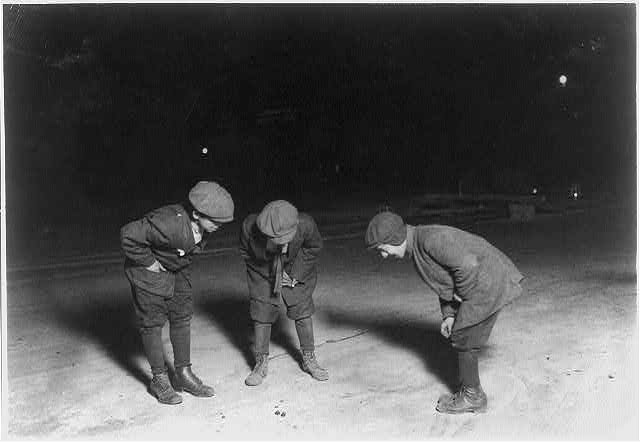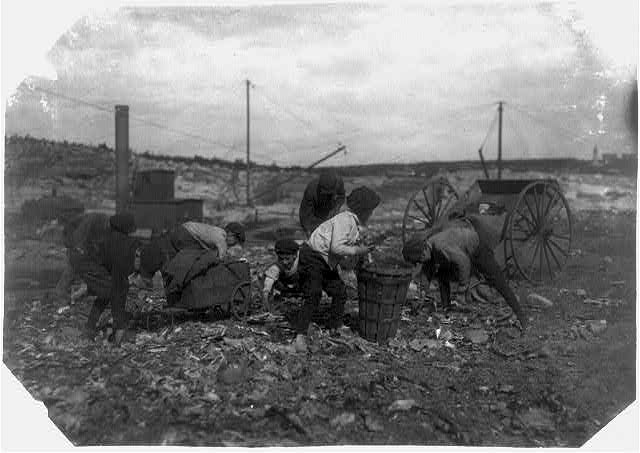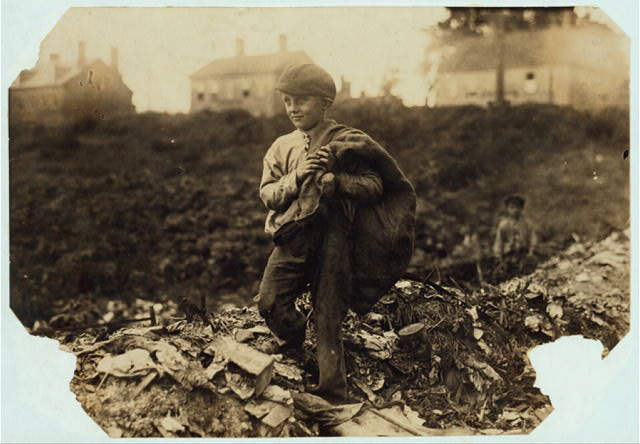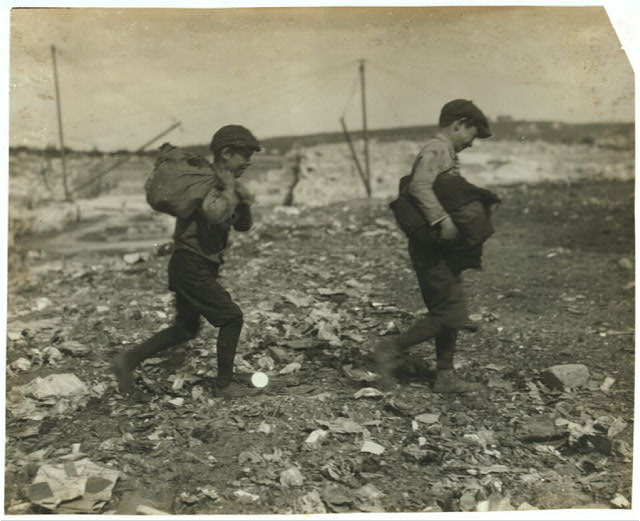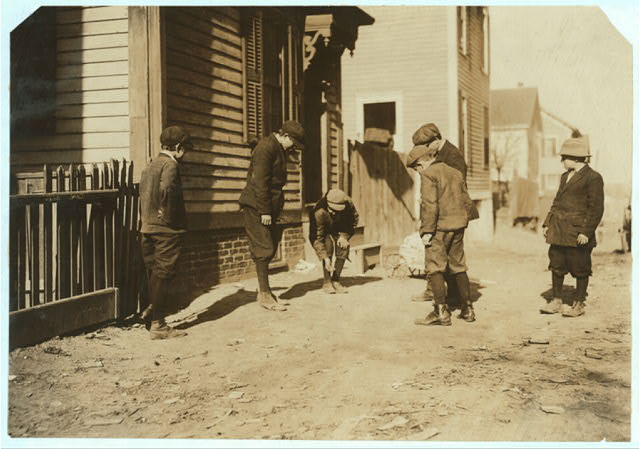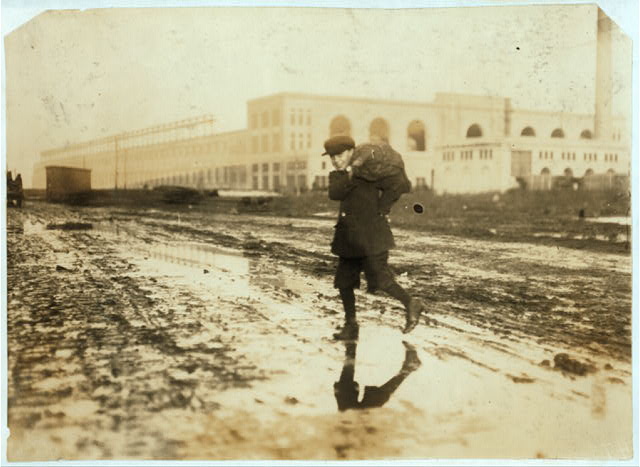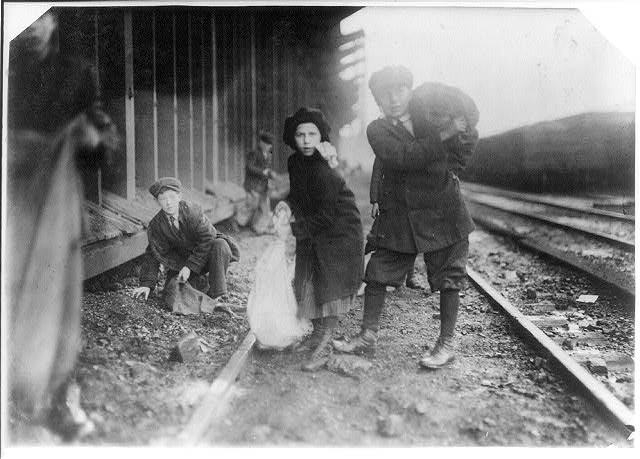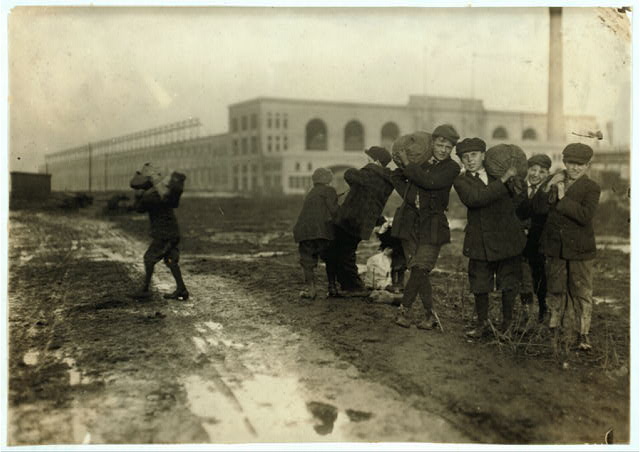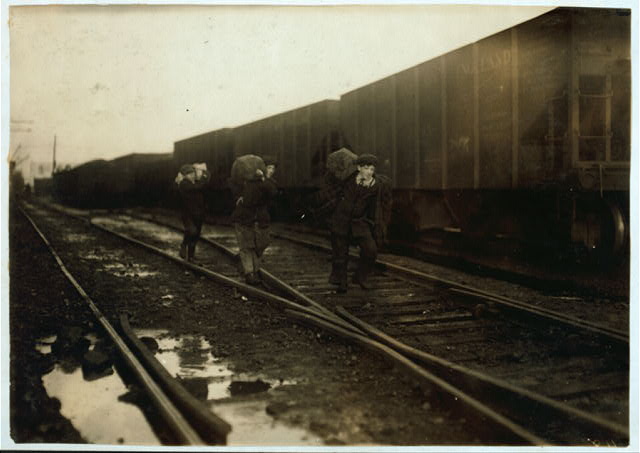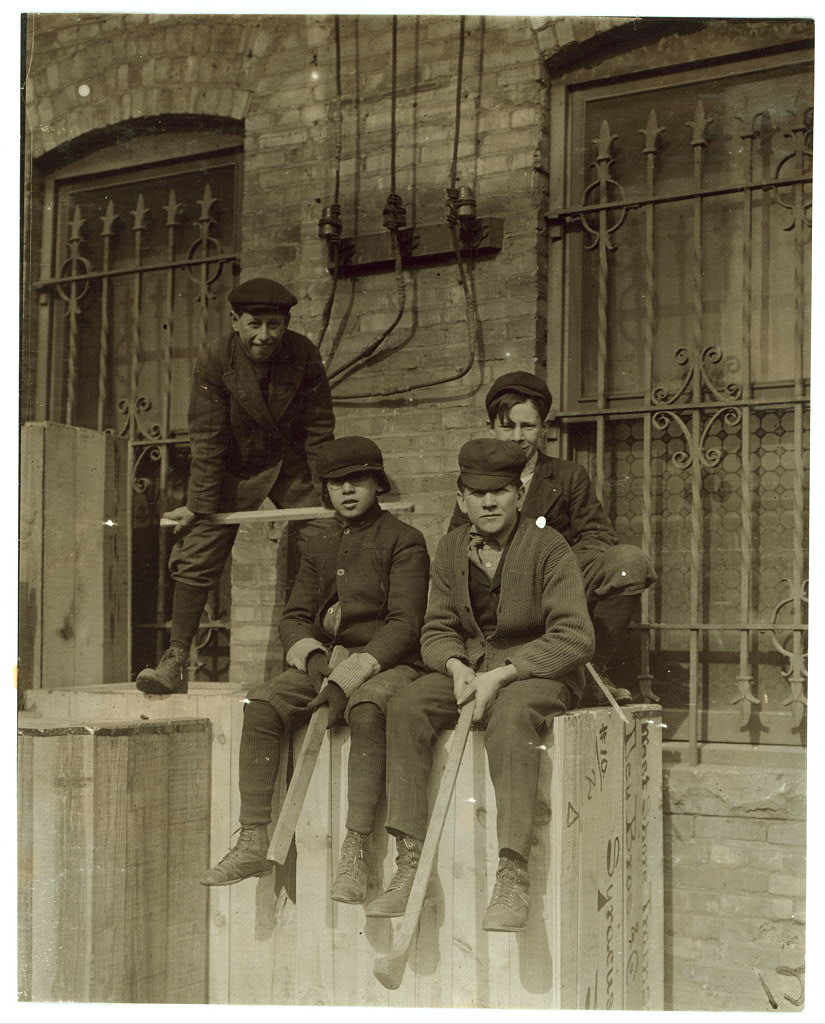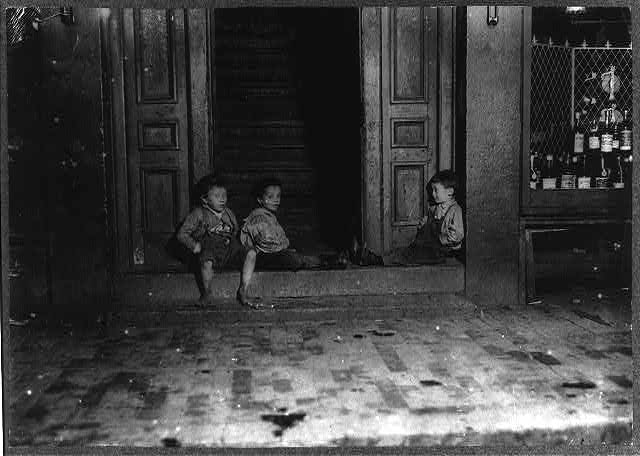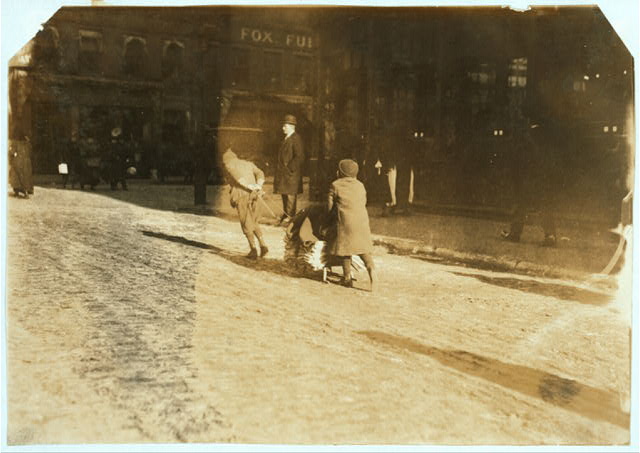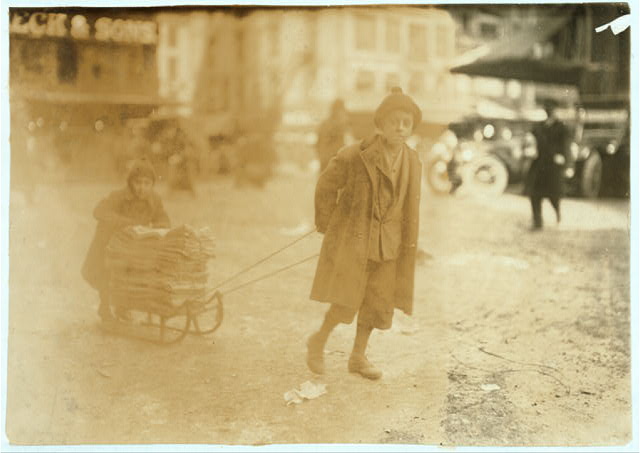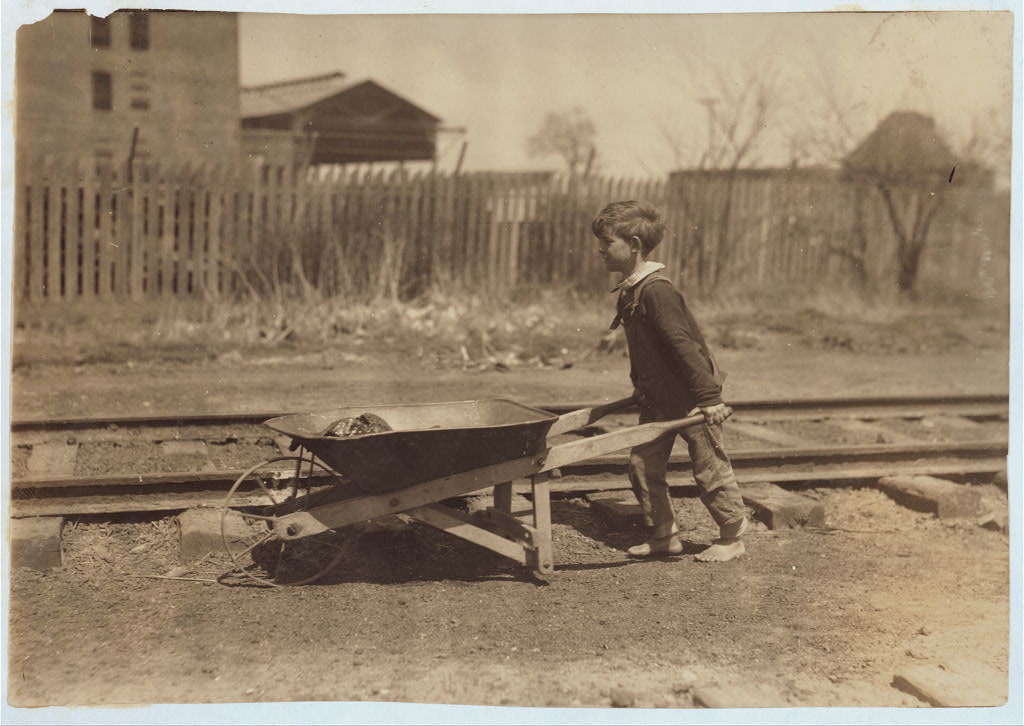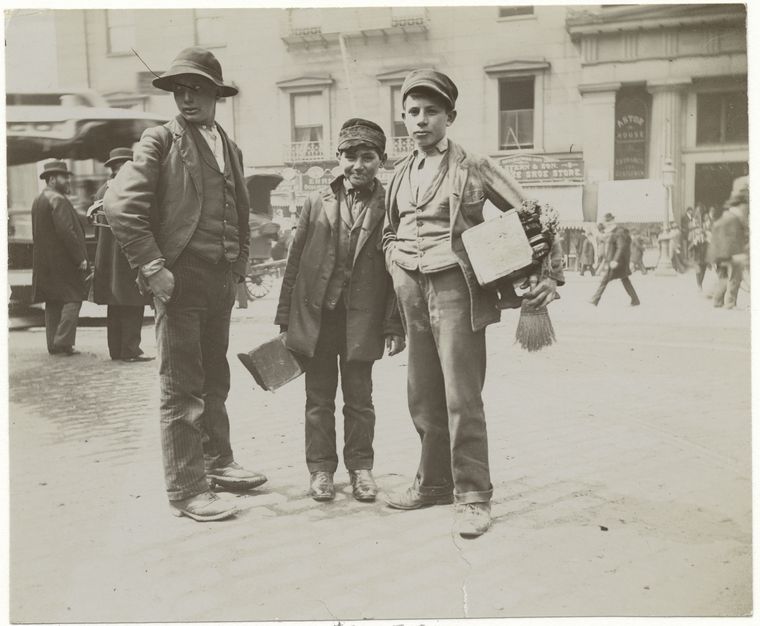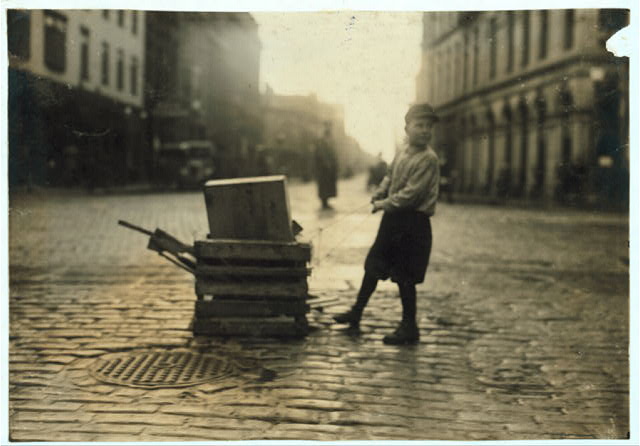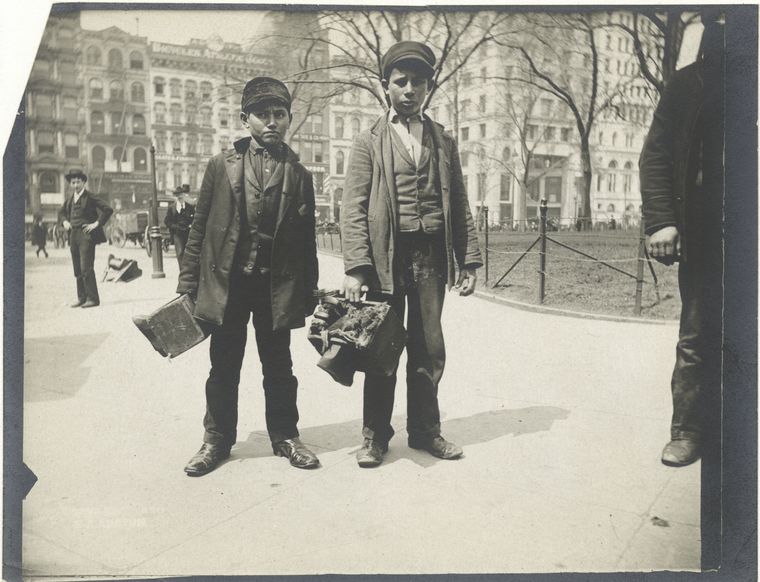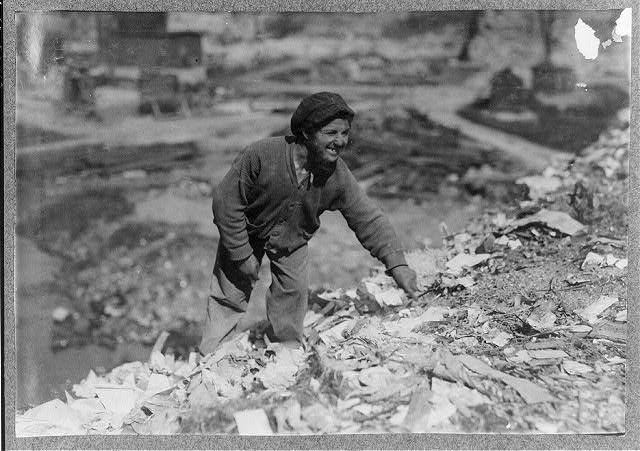By Anne M. Filiaci, Ph.D.
I. INTRODUCTION
Children have worked on the streets of towns and cities for millennia. In many places young children still do street work—begging, picking pockets, combing dumps and dumpsters for food and other items, and selling everything from trinkets to drugs. Some children work on the streets because they are alone and abandoned. Others are forced to work by exploitative adults, including their parents. In many cases, it’s a combination of the two.
" order_by="sortorder" order_direction="ASC" returns="included" maximum_entity_count="500"]People who lived in turn-of-the-20th-century New York City were hardly strangers to this type of child exploitation. Beggars often used babies and infants less than a year old as props to make money. (Kelley, Ethical Gains, p. 5.) Young boys in the street trades made money as peddlers, delivery boys, errand runners, messengers, by boot blacking (“shinin’”), and by selling newspapers. Girls often sold matches, flowers and other merchandise. In 1905, Florence Kelley spoke of “little girls” who “offered violets for sale in the streets of New York as they still offer in the streets of many cities flowers, pencils, chewing gum and other small articles.” (Kelley, Ethical Gains, pp. 11-12)
Often the children who plied these trades were under the age of ten. (Trattner, pp. 109-110.) In 1892 Jacob Riis, muckraking journalist and child advocate, recalled taking
a picture of my little vegetable-peddling friend, Edward, asleep on the front bench in evening school. Edward was nine years old and an orphan, but hard at work every day earning his own living by shouting from a pedlar’s [sic] cart. (Riis, p. 263)
Riis urged his readers to “watch the little pedlars [sic] hawking their shoe-strings, their matches, and their penny paper-pads, with the restless energy that seems so strangely out of proportion to the reward it reaps….” (Riis, p. 37). Polling an “evening school class of nineteen boys and nine girls” before writing his 1892 book, he “found twelve boys who ‘shined,’ [and] five who sold papers…. Of the girls…one twelve-year-old…minded a push-cart every day.” (Riis, p. 111)
To many if not most reformers, the fight against child labor was inextricably linked to the goal of universal education, which they believed was necessary for the very survival of the Republic. Education to them was a way for the children of new immigrants to assimilate and ascend into the middle class. It was also a way to teach American history and the foundation of American legal and civic values. As Frances Kelley wrote in 1905, “The noblest duty of the Republic is that of self preservation by so cherishing all its children that they, in turn, may become enlightened self-governing citizens.” (Kelley, Ethical Gains, p. 3) (Lovejoy, Stambler, p. 195-196, Trattner, pp. 28-29, 33).
For some who fought to abolish child labor, universal education was not a primary goal. Labor leaders and union organizers generally believed in universal education as a means of upward mobility for the children of workers. Yet they also saw children as a cheap source of labor and as a means of suppressing wages for adults. Getting children out of the work force would raise wages and improve the lot of the working classes in general.
Below are descriptions of some of the most common occupations for child street workers in late-19th-and-early-20th century New York City. These trades were certainly not the only forms of child labor during this period. But in many cases, they provided some of the starkest and most heart wrenching examples of child exploitation.
WALD AND CHILD LABOR—STREET WORKERS
II. THE UNDERGROUND
For over a decade before Wald moved to the Lower East Side, anti-child labor reformers had worked to eliminate some of the more obvious abuses of child labor in the streets—the types of labor that often functioned underground and on the margins of society—either skirting or outright breaking the law. The “padrone system,” which originated in Italy, was a perpetrator of some of the most egregious forms of this type of child exploitation in New York City. As Jacob Riis dramatically proclaimed,
These traders in human misery, adventurers of the worst type, made a practice of hiring the children of the poorest peasants in the Neapolitan mountain districts, to serve them begging, singing, and playing in the streets of American cities. (Riis, pp. 148-150)
The peasant parents of these children signed deceptive contracts, believing that they were hiring out their offspring for a temporary period of indentured servitude. Under these contracts, the young people would supposedly work “for a term of years at the end of which they were to return” to their parents, who would be paid “a fixed sum.” In reality, the life of children working for padrones was harsh and short-lived, often resembling slavery. Children “left their homes never to return” and “the money was never paid.”
Upon their arrival in the United States, these children were farmed out to local padrones, who sent them out begging and panhandling “in the streets by day,” while at night, they performed “in the lowest dens in the city.” The padrones took “all the money they made” away from the children, “beating and starving them if they did not bring home enough….” Quickly “worn…out,” it was “the Potter’s Field,” rather than their parents, that ultimately “claimed them.” (Riis, p. 148, 149, 150, Thomas interview.)
Padrones often sexually exploited the young girls under their control, using them as child prostitutes, a form of what we now call human trafficking. And padrones were not alone in this practice. Jacob Riis wrote that in the early 1880s, “Broadway from Fourteenth Street up was crowded with little girls” (he calls them “girl vagrants”) who, “under the pretence of peddling flowers and newspapers, pandered to the worst immorality.” Riis said that the girls worked “in regular gangs,”
captained and employed by a few conscienceless old harpies, who took the wages of their infamy and paid them with blows and curses if they fell short of their greed. One of the gangs…had a rendezvous in a stable near Thirtieth Street, near Broadway. The girls had latch-keys and went out and in at all hours of the night.” (Riis, pp. 272-273)
Reformers had some success in ridding the streets of New York of the worst abuses of this type of child exploitation by the 1890s. By 1892 Jacob Riis was able to report that
“The padrone has had his day; the last was convicted seven years ago, and an end has been put to the business of selling children into a slavery that meant outrage, starvation and death….” (Riis, pp. 22, 148-150.)
Yet every day during her first decade on the Lower East Side, Wald encountered children working on the streets, practicing the same “trades” as padrones had formerly hired them to do—begging, pickpocketing, and prostitution. The need to survive continued to force children into these occupations and helped to line the pockets of exploitative adults.
WALD AND CHILD LABOR—STREET WORKERS
III. MESSENGER BOYS
The round-the-clock nature of messenger work—one of the larger groups of child street laborers—meant that messenger boys ate badly, were often exhausted, had to work in “all sorts of weather,” and rarely attended school. The job of messenger often took these young boys to houses of gambling and prostitution, both of which were regular customers of delivery services. Florence Kelley quoted an 1884 report from the New York Bureau of Statistics of Labor that was specific about the “moral” temptations awaiting these workers—
‘In the American District Telegraph company they have lads who are supposed to be fourteen years old, but it would not take a connoisseur to discover that the given age is not the true one. They are boys eleven and twelve years of age, who are required to be continuously at work for at least ten hours a day, running into the worst places in all sorts of weather, mixing with all kinds of people, into houses of the most damnable disrepute, houses of assignation and gambling houses. It is very deleterious to their health and morals.’ (Kelley, Toiling Children 1889, p. 24)
Jacob Riis, echoing the Bureau’s report eight years later, reiterated its claims about the moral pitfalls inherent in messenger service, as well as the fact that many of these boys were obviously underage:
Anyone can see for himself how old some of these boys are who carry messages about the streets every day; but everybody cannot see the kind of houses they have to go to, the kind of people they meet, or the sort of influences that beset them hourly at an age when they are most easily impressed for good or bad. (Riis, p. 113.
Trattnor, writing about the subject over half a century, explicitly described the world messenger boys encountered: “For the most part, uniformed night messenger boys spent their time helping prostitutes, pimps, gamblers, and other habitués of the underworld….” (Trattner, pp. 112,114)
Florence Kelley wrote eloquently about the long-term ill effects of messenger work on individuals and on society in general. She asserted that the job not only undercut opportunities for good health, education and moral rectitude, but also eroded the work ethic of these young boys and provided no useful training for their future. An adult who had “survived” the experience would have little to “show for the years he has spent delivering messages.” Assuming that he was strong enough that his “digestion” was “unhurt,” “nerves sound” and “character untainted,” he “emerged” with “no trade, no craft, no skill of any kind, no discipline of mind or body to fit him for rising in any direction.” Kelley further asserted that years on the job served to destroy ambition and the will to succeed. The “eagerness to make a record of speed and promptness…”, a characteristic of most newly minted messenger boys, gradually “oozed away, eroded by years of poorly rewarded labor.” The normal messenger boy, to her, would be subjected to having health, educational opportunities, work ethic and integrity eroded by the job. As such, he would be of much less value to society in general as an adult. (Kelley, Ethical Gains 1905, pp 22-23)
WALD AND CHILD LABOR—STREET WORKERS
IV. NEWSBOYS
Newsboys faced many of the same hazards as messengers, and they were often even younger. Kelley pointed to the fact that “In many cities, tiny newsboys may be seen on the streets at any hour of the day or night.” (Kelley, Ethical Gains, 1905, pp. 12-13). Julia Lathrop, a Chicago settlement worker who would later become head of the United States Children’s Bureau, made use of an effective anecdote to illustrate Kelley’s point—“A tiny boy,” she recounted,
came into a hotel and asked a lady to buy a paper. When she exclaimed ‘Why! how old are you? Why aren’t you in school?’ this merchant, a recognized legal trader in most of our states, replied, ‘I am five years old. I am not old enough to go to school.’” (The Children’s Bureau, Julia C. Lathrop, American Journal of Sociology, Nov. 1912, pp. 318-330)
Newsboys, like messengers, worked long hours, often laboring from before dawn to late at night. It was not uncommon to see “tiny lads asleep on gratings in front of newspaper offices, waiting for early editions.” (Wald, House, pp. 146-149.) Because of their irregular hours, newsboys were often exposed to “vices.” Lillian Wald, who “served as chairman of a special committee of the New York Child Labor Committee, which investigated the most popular of street trades—selling and delivering newspapers,” (Wald, Windows, p. 195) claimed that newsboys headed “the list” of street workers as a “fruitful source of juvenile delinquency.” (Wald, House, pp. 146-149.) Sometimes even the parents of these young workers complained that they
kept their earnings and learned to gamble with them, that they found lodgings (often unwholesome ones) outside the home, that they stood in front of theatres and made undesirable acquaintances, and that the learned to ‘work’ sentimental people, particularly those who had just witnessed a ‘sob’ play or movie.” (Wald, Windows, p. 195, see also Wald, House, pp. 146-149)
Newboys faced hazards to their physical health—and sometimes to their lives—as well as to their character. Both Riis and Wald tell heartbreaking stories of the tragic work-related deaths of young news sellers. Riis writes of Giuseppe, a twelve-year-old newsboy, who was forced to turn over most of his proceeds to a “harsh father.” Giuseppe’s failure to bring in enough money meant he would face rage and beatings. One evening, because “business was very bad,” Giuseppe “thought a bed in the street” would be “healthier for him than” returning home to face his father’s wrath. “With three other lads in similar straits he crawled into the iron chute that ventilated the basement of the Post-office…and snuggled down on the grating.” The boys were “all asleep, when fire broke out in the cellar. The three climbed out, but Giuseppe, whose feet were wrapped in a mail-bag, was too late. He was burned to death.” (Riis, pp. 29-30)
Wald tells the story of “Sammie and his brother,” who “sold papers in front of one of the large hotels every night.” For Sammie, being sick and uncomfortable actually helped to sell papers— “The more they shivered with cold, the greater the harvest of pennies. No wonder,” Wald argued, “that the white-faced little boy stayed out long after his cold had become serious. He himself” finally “asked for admission to the hospital,” but it was too late. He “died there before his absence was noted.” (Wald, House, p. 146-149)
In some ways, the plight of newsboys was even worse than that of messengers. Because they worked as self-employed independent contractors—often called “little merchants”—they could not rely on a regular wage. They had to purchase the newspapers that they sold and/or delivered, and earned money only if they could make enough above and beyond what they spent. Newsboys were also responsible for debt collection. If their customers did not pay, they personally—not the newspapers—lost the money. (Trattner, p. 110)
Precisely because newsboys were seen as self-employed entrepreneurs, the reform message often flew in the face of a national rags-to-riches mythology earlier promulgated by authors like Horatio Alger (see Rough and Ready: Or Life Among the New York Newsboys (1869)). In these myths, newsboys represented the American dream. They embodied the notion that success was within reach of even the poorest children.
Reformers acknowledged that these legends were hard to counter. Wald writes of a “juvenile literature of more than thirty years ago” that
glorified the newsboy and his improbable financial and social achievements, and interest in him was heightened by a series of pictures by a popular painter, wherein ragged youngsters of an extraordinary cleanliness of face were portrayed as newsboys and bootblacks. Wald, House, pp. 146-149)
Wald, “aware that” the American dream was indeed real for a few, noted that “numerous readers will recall instances of remarkable achievements by the barefoot boy, the wide-awake young news-seller.” However, while admitting that she too has “known the exceptional lad who has accomplished marvels in the teeth of, sometimes because of, great disadvantages,” Wald also states that she, “for one” had “no illusions” as to the outcome for the great majority of children. (Wald, House, p. 146-149)
WALD AND CHILD LABOR—STREET WORKERS
V. CONCLUSION
Along with her friends and colleagues in the reform movement, Wald had quickly come to the conclusion that street work had a negative developmental effect on the health, education, work ethic and integrity of children, and thus for their hopes for the future. In 1902, she joined the New York Child Labor Committee (chaired by Robert Hunter, head worker of the University Settlement) (Carson, p. 110, Davis, p. 129), and was “placed upon a committee to investigate the conditions of child labor in that city.” Her particular “part of the work” would be “a study of the child labor on the streets.” (American Journal of Nursing, Editor’s Miscellany, Aug. 1902, p. 971)
Wald’s committee collected data and evidence that reinforced what she and other reformers already knew anecdotally. Since children in the street trades spent their days in the constant noise of the city’s thoroughfares, dodging horses, carriages, wagons—and later, automobiles—they were prone to nervousness and anxiety. They often suffered from chronic fatigue, the result of eating and sleeping at irregular intervals. The fatigue and irregular hours in turn led to their frequent truancy from school. Street workers, more likely to be exposed to smoking, drinking and gambling, often took up these unhealthy habits as a way to pass the time. (Trattner, p. 110-111.) Usually lacking adult supervision, children street workers were also more likely than non-working children to commit crimes. (Trattner, pp. 111-112)
As Wald’s housemate Florence Kelley discussed in a paper given at a convention in 1896, having children work at an early age—whether as messenger boys or cash girls—gave them neither skills nor education, burned them out before they were adults, and exposed them to “temptations” that would result in both legal jeopardy and risks to their health. (Blumberg, pp. 164-165) Frederick A. King of the University Settlement succinctly summarized the problem: “‘The life of the street’” he said, “‘is at best a rough school of experience and at worst a free field in which the most evil and corrupting influences may work against the morals of the community.’” (Trattner, p. 110-111.)
Bibliography
American Journal of Nursing, “Editor’s Miscellany,” The American Journal of Nursing , Vol. 2, No. 11 (Aug., 1902), pp. 970-973 Published by: Lippincott Williams & Wilkins Article Stable URL: http://www.jstor.org/stable/3402172 , p. 971.
Blumberg, Dorothy Rose, Florence Kelley: The Making of a Social Pioneer, New York: Augustus M. Kelley, 1966, pp. 164-65.
Carson, Mina, Settlement Folk: Social Thought and the American Settlement Movement, 1885-1930, Chicago: University of Chicago Press, 1990, p. 110.
Davis, Allen F., Spearheads for Reform: The Social Settlements and the Progressive Movement, 1890-1914, New York, Oxford University Press, 1967, p. 129.
[Kelley] Wischnewetzky, Florence Kelley, Our Toiling Children, Chicago, Women’s Temperance Publication Association, 1889, p. 24. https://florencekelley.northwestern.edu/documents/fk_70090029/ Current 9/23/2020.
Kelley, Florence, Some Ethical Gains Through Legislation, New York: The Macmillan Company, 1905, pp. 3, 5, 11-13, 22-23.
Lathrop, Julia C., “The Children’s Bureau,” American Journal of Sociology , Vol. 18, No. 3 (Nov., 1912), pp. 318-330 Published by: The University of Chicago Press Article Stable URL: http://www.jstor.org/stable/2763380
Lovejoy, Owen, “The Function of Education in Abolishing Child Labor,” Annals of the American Academy of Political and Social Science , Vol. 32, Supplement 22. Child Labor and Social Progress. Proceedings of the Fourth Annual Meeting of the National Child Labor Committee (Jul., 1908), pp. 80-91.
Riis, Jacob, The Children of the Poor, New York, Charles Scribner’s Sons, 1908 (c1892), pp. 22, 29-30, 37, 111, 113, 148-150, 263, 272-273.
Stambler, Moses, “The Effect of Compulsory Education and Child Labor Laws on High School Attendance in New York City, 1898-1917,” Source: History of Education Quarterly, Vol. 8, No. 2 (Summer, 1968) pp. 195-196.
Thomas, Teresa Fava Thomas “Interview,” on the padrone system in We the Italians: Two Flags, One Heart, Website, Sept. 8, 2020. https://www.wetheitalians.com/interviews/italian-slaves-usa-padrone-system Current 11/2/20.
Trattner, Walter I., Crusade for the Children: A History of the National Child Labor Committee and Child Labor Reform in America, Chicago: Quadrangle Books, 1970, pp. 28-29, 33, 109-112, 114.
Wald, Lillian D., The House on Henry Street, NY: Henry Holt & Co., 1915, pp. 133, 146-149.
Wald, Lillian D., Windows on Henry Street, Boston: Little Brown and Company, 1934, p. 178, 192-193, 195.
WILLIAMS, [Epstein], Beryl Williams, Lillian Wald: Angel of Henry Street [author’s name on title page is “Beryl Williams”], NY: Julian Messner, Inc., 1948, 168-169.
Woods, Robert A. and Albert J. Kennedy, The Settlement Horizon: A National Estimate, New York: Russell Sage Foundation, 1922, p. 187.
Illustrations
Hine, Lewis Wickes, Among Ash Barrels. Garbage Gleaners. Boston, MA, Oct. 1909
Medium: 1 photographic print. Reproduction Number: LC-DIG-nclc-04531 (color digital file from b&w original print) Rights Advisory: No known restrictions on publication. For information see: “National Child Labor Committee (Lewis Hine photographs),” https://hdl.loc.gov/loc.pnp/res.097.hine Access Advisory: For reference access, please use the digital item to preserve the fragile original item. Call Number: LOT 7483, v. 1, no. 0865 [P&P]
Repository: Library of Congress Prints and Photographs Division Washington, D.C. 20540 USA https://hdl.loc.gov/loc.pnp/pp.print Link To Illustration Current 12/1/20
Hines, Lewis Wickes, “Gimme a smoke.” Street boys. Location: Boston, Massachusetts. Date Created/Published: 1909 October. Medium: 1 photographic print. Reproduction Number: LC-DIG-nclc-04533 (color digital file from b&w original print) LC-DIG-nclc-03305 (color digital file from b&w original print) LC-USZ62-30457 (b&w film copy negative) Rights Advisory: No known restrictions on publication. For information see: “National Child Labor Committee (Lewis Hine photographs),” https://hdl.loc.gov/loc.pnp/res.097.hine Access Advisory: For reference access, please use the digital item to preserve the fragile original item.
Call Number: LOT 7483, v. 1, no. 0867 [P&P] LOT 7480, v. 1, no. 0867
Repository: Library of Congress Prints and Photographs Division Washington, D.C. 20540 USA https://hdl.loc.gov/loc.pnp/pp.print Link To Illustration Current 12/1/20
Hines, Lewis Wickes, Market scene. Location: Boston, Massachusetts. Date Created/Published: 1909 October. Medium: 1 photographic print. Reproduction Number: LC-DIG-nclc-04534 (color digital file from b&w original print) LC-USZ62-58924 (b&w film copy negative) Rights Advisory: No known restrictions on publication. For information see: “National Child Labor Committee (Lewis Hine photographs),” https://hdl.loc.gov/loc.pnp/res.097.hine Access Advisory: For reference access, please use the digital item to preserve the fragile original item.
Call Number: LOT 7483, v. 1, no. 0868 [P&P] Repository: Library of Congress Prints and Photographs Division Washington, D.C. 20540 USA https://hdl.loc.gov/loc.pnp/pp.print
Link To Illustration Current 12/1/20
Hine, Lewis Wickes, Swiping Behind the Cop’s Back. Boston 1915 Exhibit. Location: Boston, Massachusetts. Date Created/Published: 1909 October. Medium: 1 photographic print.
Reproduction Number: LC-DIG-nclc-04535 (color digital file from b&w original print) LC-USZ62-58925 (b&w film copy negative) Rights Advisory: No known restrictions on publication. For information see: “National Child Labor Committee (Lewis Hine photographs),” https://hdl.loc.gov/loc.pnp/res.097.hine Access Advisory: For reference access, please use the digital item to preserve the fragile original item. Call Number: LOT 7483, v. 1, no. 0873 [P&P]
Repository: Library of Congress Prints and Photographs Division Washington, D.C. 20540 USA https://hdl.loc.gov/loc.pnp/pp.print
Link To Illustration Current 12/1/20
Hine, Lewis Wickes, Immigrants in night school. Location: Boston, Massachusetts. Date Created/Published: 1909 October. Medium: 1 photographic print. Reproduction Number: LC-DIG-nclc-04549 (color digital file from b&w original print) Rights Advisory: No known restrictions on publication. For information see: “National Child Labor Committee (Lewis Hine photographs),” https://hdl.loc.gov/loc.pnp/res.097.hine Access Advisory: For reference access, please use the digital item to preserve the fragile original item. Call Number: LOT 7483, v. 1, no. 0894 [P&P] Repository: Library of Congress Prints and Photographs Division Washington, D.C. 20540 USA https://hdl.loc.gov/loc.pnp/pp.print Link To Illustration Current 12/1/20
Hine, Lewis Wickes, Boys picking over garbage on “the Dumps.” Boston. See 906-907. Location: Boston, Massachusetts. Date Created/Published: 1909 October. Medium: 1 photographic print. Reproduction Number: LC-DIG-nclc-04552 (color digital file from b&w original print) LC-USZ62-30471 (b&w film copy negative) Rights Advisory: No known restrictions on publication. For information see: “National Child Labor Committee (Lewis Hine photographs),” https://hdl.loc.gov/loc.pnp/res.097.hine Access Advisory: For reference access, please use the digital item to preserve the fragile original item. Call Number: LOT 7483, v. 1, no. 0899 [P&P] Repository: Library of Congress Prints and Photographs Division Washington, D.C. 20540 USA https://hdl.loc.gov/loc.pnp/pp.print Link To Illustration Current 12/1/20
Hine, Lewis Wickes, Boys and Girls Working on the Dumps. (See other end of same Dump in 907). Boston 1915 Exhibit. Location: Boston, Massachusetts. Date Created/Published: 1909 October. Medium: 1 photographic print. 1 negative : glass ; 5 x 7 in. Reproduction Number: LC-DIG-nclc-04556 (color digital file from b&w original print) LC-DIG-nclc-05428 (b&w digital file from original glass negative) LC-USZ62-65624 (b&w film copy negative) Rights Advisory: No known restrictions on publication. For information see: “National Child Labor Committee (Lewis Hine photographs),” https://hdl.loc.gov/loc.pnp/res.097.hine Access Advisory: For reference access, please use the digital item to preserve the fragile original item.
Call Number: LOT 7483, v. 1, no. 0906 [P&P] LC-H5- 906
Repository: Library of Congress Prints and Photographs Division Washington, D.C. 20540 USA https://hdl.loc.gov/loc.pnp/pp.print Link To Illustration Current 12/1/20
Hine, Lewis Wickes, Little Girl Woodpickers Making Up a Load. Location: Boston, Massachusetts. Date Created/Published: 1909 October. Medium: 1 photographic print.
Reproduction Number: LC-DIG-nclc-04558 (color digital file from b&w original print)
Rights Advisory: No known restrictions on publication. For information see: “National Child Labor Committee (Lewis Hine photographs),” https://hdl.loc.gov/loc.pnp/res.097.hine
Access Advisory: For reference access, please use the digital item to preserve the fragile original item. Call Number: LOT 7483, v. 1, no. 0912 [P&P] Repository: Library of Congress Prints and Photographs Division Washington, D.C. 20540 USA https://hdl.loc.gov/loc.pnp/pp.print
Link To Illustration Current 12/1/20
Hine, Lewis Wickes, Late at night. Street boys. “Jest hanging around.” Location: Boston, Massachusetts. Date Created/Published: 1909 October. Medium: 1 photographic print.
Reproduction Number: LC-DIG-nclc-04538 (color digital file from b&w original print) LC-USZ62-30469 (b&w film copy negative) LC-USZ6-1250 (b&w film copy negative)
Rights Advisory: No known restrictions on publication. For information see: “National Child Labor Committee (Lewis Hine photographs),” https://hdl.loc.gov/loc.pnp/res.097.hine
Access Advisory: For reference access, please use the digital item to preserve the fragile original item. Call Number: LOT 7483, v. 1, no. 0881 [P&P]
Repository: Library of Congress Prints and Photographs Division Washington, D.C. 20540 USA https://hdl.loc.gov/loc.pnp/pp.print Link To Illustration Current 12/1/20
Hine, Lewis Wickes, Newsie. Location: St. Louis, Missouri. Date Created/Published: 1910 May.
Medium: 1 photographic print. Reproduction Number: LC-DIG-nclc-04663 (color digital file from b&w original print) Rights Advisory: No known restrictions on publication. For information see: “National Child Labor Committee (Lewis Hine photographs),” https://hdl.loc.gov/loc.pnp/res.097.hine Access Advisory: For reference access, please use the digital item to preserve the fragile original item. Call Number: LOT 7483, v. 1, no. 1468 [P&P]
Repository: Library of Congress Prints and Photographs Division Washington, D.C. 20540 USA https://hdl.loc.gov/loc.pnp/pp.print Link To Illustration Current 12/1/20
Hine, Lewis Wickes, “This boy and brother were picking discarded fruit out of barrels in market near 14th St. N.Y. City. He was also (when apparently unobserved) stealing good fruit from their barrels.” Location: New York, New York (State) Creator(s): Hine, Lewis Wickes, 1874-1940, photographer Date Created/Published: 1910 July. Medium: 1 photographic print. Reproduction Number: LC-DIG-nclc-04678 (color digital file from b&w original print) LC-USZ62-63415 (b&w film copy negative) Rights Advisory: No known restrictions on publication. For information see: “National Child Labor Committee (Lewis Hine photographs),” https://hdl.loc.gov/loc.pnp/res.097.hine Access Advisory: For reference access, please use the digital item to preserve the fragile original item. Call Number: LOT 7483, v. 1, no. 1668 [P&P]
Repository: Library of Congress Prints and Photographs Division Washington, D.C. 20540 USA https://hdl.loc.gov/loc.pnp/pp.print Link To Illustration Current 12/8/20
Hine, Lewis Wickes, “Pitching Pennies,” Providence, R.I. (For Child Welfare Exhibit 1912-13.) Location: Providence, Rhode Island. Creator(s): Hine, Lewis Wickes, 1874-1940, photographer
Date Created/Published: 1912 November. Medium: 1 photographic print.
Reproduction Number: LC-DIG-nclc-04792 (color digital file from b&w original print) Rights Advisory: No known restrictions on publication. For information see: “National Child Labor Committee (Lewis Hine photographs),” https://hdl.loc.gov/loc.pnp/res.097.hine Access Advisory: For reference access, please use the digital item to preserve the fragile original item.
Call Number: LOT 7483, v. 2, no. 3168 [P&P] Repository: Library of Congress Prints and Photographs Division Washington, D.C. 20540 USA https://hdl.loc.gov/loc.pnp/pp.print Link To Illustration Current 12/8/20
Hines, Lewis Wickes, (For Child Welfare Exhibit 1912-13.) “Shooting craps,” Providence, R.I. Location: Providence, Rhode Island. Creator(s): Hine, Lewis Wickes, 1874-1940, photographer
Date Created/Published: 1912 November. Medium: 1 photographic print. Reproduction Number: LC-DIG-nclc-04794 (color digital file from b&w original print) Rights Advisory: No known restrictions on publication. For information see: “National Child Labor Committee (Lewis Hine photographs),” https://hdl.loc.gov/loc.pnp/res.097.hine Access Advisory: For reference access, please use the digital item to preserve the fragile original item. Call Number: LOT 7483, v. 2, no. 3171 [P&P] Repository: Library of Congress Prints and Photographs Division Washington, D.C. 20540 USA https://hdl.loc.gov/loc.pnp/pp.print Link To Illustration Current 12/8/20
Hine, Lewis Wickes, Title: (For Child Welfare Exhibit 1912-13.) “A midnight crap game in the street near Post Office,” Providence, R.I. Nov. 23, 1912. One 12 years old, one 14. One had been shooting here a couple of hours Location: Providence, Rhode Island. Creator(s): Hine, Lewis Wickes, 1874-1940, photographer. Date Created/Published: 1912 November 23.
Medium: 1 photographic print. Reproduction Number: LC-DIG-nclc-04802 (color digital file from b&w original print) LC-USZ62-63615 (b&w film copy negative). Rights Advisory: No known restrictions on publication. For information see: “National Child Labor Committee (Lewis Hine photographs),” https://hdl.loc.gov/loc.pnp/res.097.hine Access Advisory: For reference access, please use the digital item to preserve the fragile original item. Call Number: LOT 7483, v. 2, no. 3209 [P&P] Repository: Library of Congress Prints and Photographs Division Washington, D.C. 20540 USA https://hdl.loc.gov/loc.pnp/pp.print Link To Illustration Current 12/8/20
Hine, Lewis Wickes, “Two children going through the “Dumps.”” Location: [Rhode Island?]
Creator(s): Hine, Lewis Wickes, 1874-1940, photographer. Date Created/Published: [1912 November?] Medium: 1 photographic print. Reproduction Number: LC-DIG-nclc-04811 (color digital file from b&w original print) Rights Advisory: No known restrictions on publication. For information see: “National Child Labor Committee (Lewis Hine photographs),” https://hdl.loc.gov/loc.pnp/res.097.hine Access Advisory: For reference access, please use the digital item to preserve the fragile original item. Call Number: LOT 7483, v. 2, no. 3245 [P&P]
Repository: Library of Congress Prints and Photographs Division Washington, D.C. 20540 USA https://hdl.loc.gov/loc.pnp/pp.print Link To Illustration Current 12/8/20
Hine, Lewis Wickes, Title: Firewood. Location: Boston, Massachusetts / Lewis W. Hine.
Creator(s): Hine, Lewis Wickes, 1874-1940, photographer. Date Created/Published: 1917 January 27. Medium: 1 photographic print. Reproduction Number: LC-DIG-nclc-05153 (color digital file from b&w original print) Rights Advisory: No known restrictions on publication. For information see: “National Child Labor Committee (Lewis Hine photographs),” https://hdl.loc.gov/loc.pnp/res.097.hine Access Advisory: For reference access, please use the digital item to preserve the fragile original item. Call Number: LOT 7483, v. 2, no. 4682 [P&P]
Repository: Library of Congress Prints and Photographs Division Washington, D.C. 20540 USA https://hdl.loc.gov/loc.pnp/pp.print Link To Illustration Current 12/8/20
Hine, Lewis Wickes, Title: Taking bags home to be mended. 5 to 11 years old. Market. Location: Boston, Massachusetts / Lewis W. Hine. Creator(s): Hine, Lewis Wickes, 1874-1940, photographer. Date Created/Published: 1917 January 27. Medium: 1 photographic print.
Reproduction Number: LC-DIG-nclc-05154 (color digital file from b&w original print)
Rights Advisory: No known restrictions on publication. For information see: “National Child Labor Committee (Lewis Hine photographs),” https://hdl.loc.gov/loc.pnp/res.097.hine
Access Advisory: For reference access, please use the digital item to preserve the fragile original item. Call Number: LOT 7483, v. 2, no. 4683 [P&P] Repository: Library of Congress Prints and Photographs Division Washington, D.C. 20540 USA https://hdl.loc.gov/loc.pnp/pp.print Link To Illustration Current 12/8/20
Hine, Lewis Wickes, Title: [Taking bags home to be mended. 5 to 11 years old. Market.] Location: [Boston, Massachusetts]. / [Lewis W. Hine] Creator(s): Hine, Lewis Wickes, 1874-1940, photographer Date Created/Published: [1917 January 27] Medium: 1 photographic print.
Reproduction Number: LC-DIG-nclc-05155 (color digital file from b&w original print)
Rights Advisory: No known restrictions on publication. For information see: “National Child Labor Committee (Lewis Hine photographs),” https://hdl.loc.gov/loc.pnp/res.097.hine
Access Advisory: For reference access, please use the digital item to preserve the fragile original item. Call Number: LOT 7483, v. 2, no. 4683-A [P&P] Repository: Library of Congress Prints and Photographs Division Washington, D.C. 20540 USA https://hdl.loc.gov/loc.pnp/pp.print Link To Illustration Current 12/8/20
Hine, Lewis Wickes, Title: Firewood. Location: Boston, Massachusetts / Lewis W. Hine.
Creator(s): Hine, Lewis Wickes, 1874-1940, photographer Date Created/Published: 1917 January 27. Medium: 1 photographic print. Reproduction Number: LC-DIG-nclc-05153 (color digital file from b&w original print) Rights Advisory: No known restrictions on publication. For information see: “National Child Labor Committee (Lewis Hine photographs),” https://hdl.loc.gov/loc.pnp/res.097.hine Access Advisory: For reference access, please use the digital item to preserve the fragile original item. Call Number: LOT 7483, v. 2, no. 4682 [P&P]
Repository: Library of Congress Prints and Photographs Division Washington, D.C. 20540 USA https://hdl.loc.gov/loc.pnp/pp.print Link To Illustration Current 12/8/20
Hine, Lewis Wickes, Title: Scavengers. Pine Street Dump. Location: Fall River, Massachusetts / Lewis W. Hine. Creator(s): Hine, Lewis Wickes, 1874-1940, photographer Date Created/Published: 1916 June 22. Medium: 1 photographic print. Reproduction Number: LC-DIG-nclc-05075 (color digital file from b&w original print) Rights Advisory: No known restrictions on publication. For information see: “National Child Labor Committee (Lewis Hine photographs),” https://hdl.loc.gov/loc.pnp/res.097.hine Access Advisory: For reference access, please use the digital item to preserve the fragile original item. Call Number: LOT 7483, v. 2, no. 4317 [P&P] Repository: Library of Congress Prints and Photographs Division Washington, D.C. 20540 USA https://hdl.loc.gov/loc.pnp/pp.print Link To Illustration Current 12/8/20
Hine, Lewis Wickes, Title: Christie Stubbs. 11 year old scavenger – Pine Street Dumps – Lives 141 Plain St. Location: Fall River, Massachusetts / Lewis W. Hine. Creator(s): Hine, Lewis Wickes, 1874-1940, photographer. Date Created/Published: 1916 June 22. Medium: 1 photographic print. Reproduction Number: LC-DIG-nclc-05083 (color digital file from b&w original print) LC-USZ62-102398 (b&w film copy negative). Rights Advisory: No known restrictions on publication. For information see: “National Child Labor Committee (Lewis Hine photographs),” https://hdl.loc.gov/loc.pnp/res.097.hine Access Advisory: For reference access, please use the digital item to preserve the fragile original item. Call Number: LOT 7483, v. 2, no. 4327 [P&P] Repository: Library of Congress Prints and Photographs Division Washington, D.C. 20540 USA https://hdl.loc.gov/loc.pnp/pp.print Link To Illustration Current 12/8/20
Hine, Lewis Wickes, Title: Stealing coal from railroad coal-yard. Location: Boston, Massachusetts / Lewis W. Hine. Creator(s): Hine, Lewis Wickes, 1874-1940, photographer
Date Created/Published: 1917 January 29. Medium: 1 photographic print. Reproduction Number: LC-DIG-nclc-05182 (color digital file from b&w original print). Rights Advisory: No known restrictions on publication. For information see: “National Child Labor Committee (Lewis Hine photographs),” https://hdl.loc.gov/loc.pnp/res.097.hine Access Advisory: For reference access, please use the digital item to preserve the fragile original item. Call Number: LOT 7483, v. 2, no. 4714 [P&P] Repository: Library of Congress Prints and Photographs Division Washington, D.C. 20540 USA https://hdl.loc.gov/loc.pnp/pp.print Link To Illustration Current 12/8/20
Hine, Lewis Wickes, Title: [Stealing coal from railroad coal-yard.] Location: [Boston, Massachusetts] / Lewis W. Hine. Creator(s): Hine, Lewis Wickes, 1874-1940, photographer
Date Created/Published: [1917 January 29] Medium: 1 photographic print. Reproduction Number: LC-DIG-nclc-05183 (color digital file from b&w original print) Rights Advisory: No known restrictions on publication. For information see: “National Child Labor Committee (Lewis Hine photographs),” https://hdl.loc.gov/loc.pnp/res.097.hine Access Advisory: For reference access, please use the digital item to preserve the fragile original item. Call Number: LOT 7483, v. 2, no. 4715 [P&P] Repository: Library of Congress Prints and Photographs Division Washington, D.C. 20540 USA https://hdl.loc.gov/loc.pnp/pp.print Link To Illustration Current 12/8/20
Hine, Lewis Wickes, Title: [Stealing coal from railroad coal-yard.] Location: [Boston, Massachusetts] / Lewis W. Hine. Creator(s): Hine, Lewis Wickes, 1874-1940, photographer
Date Created/Published: [1917 January 29] Medium: 1 photographic print.
Reproduction Number: LC-DIG-nclc-05184 (color digital file from b&w original print)
Rights Advisory: No known restrictions on publication. For information see: “National Child Labor Committee (Lewis Hine photographs),” https://hdl.loc.gov/loc.pnp/res.097.hine
Access Advisory: For reference access, please use the digital item to preserve the fragile original item. Call Number: LOT 7483, v. 2, no. 4716 [P&P] Repository: Library of Congress Prints and Photographs Division Washington, D.C. 20540 USA https://hdl.loc.gov/loc.pnp/pp.print Link To Illustration Current 12/8/20
Hine, Lewis Wickes, Title: [Stealing coal from railroad coal-yard.] Location: [Boston, Massachusetts]. / Lewis W. Hine. Creator(s): Hine, Lewis Wickes, 1874-1940, photographer
Date Created/Published: [1917 January 29] Medium: 1 photographic print.
Reproduction Number: LC-DIG-nclc-05185 (color digital file from b&w original print) LC-USZ62-34981 (b&w film copy negative) Rights Advisory: No known restrictions on publication. For information see: “National Child Labor Committee (Lewis Hine photographs),” https://hdl.loc.gov/loc.pnp/res.097.hine Access Advisory: For reference access, please use the digital item to preserve the fragile original item. Call Number: LOT 7483, v. 2, no. 4717 [P&P]
Repository: Library of Congress Prints and Photographs Division Washington, D.C. 20540 USA https://hdl.loc.gov/loc.pnp/pp.print Link To Illustration Current 12/8/20
Hine, Lewis Wickes, Title: [Stealing coal from railroad coal-yard.] Location: [Boston, Massachusetts] / Lewis W. Hine. Creator(s): Hine, Lewis Wickes, 1874-1940, photographer
Date Created/Published: [1917 January 29] Medium: 1 photographic print. Reproduction Number: LC-DIG-nclc-05186 (color digital file from b&w original print) Rights Advisory: No known restrictions on publication. For information see: “National Child Labor Committee (Lewis Hine photographs),” https://hdl.loc.gov/loc.pnp/res.097.hine Access Advisory: For reference access, please use the digital item to preserve the fragile original item. Call Number: LOT 7483, v. 2, no. 4718 [P&P] Repository: Library of Congress Prints and Photographs Division Washington, D.C. 20540 USA https://hdl.loc.gov/loc.pnp/pp.print Link To Illustration Current 12/8/20
Hine, Lewis Wickes, Title: Scavengers. Miss Eddy interested. Location: Fall River, Massachusetts / Lewis W. Hine. Creator(s): Hine, Lewis Wickes, 1874-1940, photographer
Date Created/Published: 1916 June 16. Medium: 1 photographic print. Reproduction Number: LC-DIG-nclc-05046 (color digital file from b&w original print) LC-USZ62-19965 (b&w film copy negative) Rights Advisory: No known restrictions on publication. For information see: “National Child Labor Committee (Lewis Hine photographs),” https://hdl.loc.gov/loc.pnp/res.097.hine Access Advisory: For reference access, please use the digital item to preserve the fragile original item. Call Number: LOT 7483, v. 2, no. 4223 [P&P]
Repository: Library of Congress Prints and Photographs Division Washington, D.C. 20540 USA https://hdl.loc.gov/loc.pnp/pp.print Link To Illustration Current 12/15/20
Hine, Lewis Wickes, Title: Toting wood – Scavenger. Location: Fall River, Massachusetts / Lewis W. Hine. Creator(s): Hine, Lewis Wickes, 1874-1940, photographer. Date Created/Published: 1916 June 16. Medium: 1 photographic print. Reproduction Number: LC-DIG-nclc-05048 (color digital file from b&w original print) Rights Advisory: No known restrictions on publication. For information see: “National Child Labor Committee (Lewis Hine photographs),” https://hdl.loc.gov/loc.pnp/res.097.hine Access Advisory: For reference access, please use the digital item to preserve the fragile original item. Call Number: LOT 7483, v. 2, no. 4225 [P&P] Repository: Library of Congress Prints and Photographs Division Washington, D.C. 20540 USA https://hdl.loc.gov/loc.pnp/pp.print Link To Illustration Current 12/15/20
Hine, Lewis Wickes, Title: On the Pleasant Street Dump. Location: Fall River, Massachusetts / Lewis W. Hine. Creator(s): Hine, Lewis Wickes, 1874-1940, photographer. Date Created/Published: 1916 June 21. Medium: 1 photographic print. Reproduction Number: LC-DIG-nclc-05061 (color digital file from b&w original print) LC-USZ62-102397 (b&w film copy negative) Rights Advisory: No known restrictions on publication. For information see: “National Child Labor Committee (Lewis Hine photographs),” https://hdl.loc.gov/loc.pnp/res.097.hine
Access Advisory: For reference access, please use the digital item to preserve the fragile original item. Call Number: LOT 7483, v. 2, no. 4282 [P&P] Repository: Library of Congress Prints and Photographs Division Washington, D.C. 20540 USA https://hdl.loc.gov/loc.pnp/pp.print Link To Illustration Current 12/15/20
Hine, Lewis Wickes, Title: Pine Street Dump Scavenger. Location: Fall River, Massachusetts / Lewis W. Hine. Creator(s): Hine, Lewis Wickes, 1874-1940, photographer. Date Created/Published: 1916 June 22. Medium: 1 photographic print. Reproduction Number: LC-DIG-nclc-05086 (color digital file from b&w original print) LC-USZ62-86813 (b&w film copy negative) Rights Advisory: No known restrictions on publication. For information see: “National Child Labor Committee (Lewis Hine photographs),” https://hdl.loc.gov/loc.pnp/res.097.hine
Access Advisory: For reference access, please use the digital item to preserve the fragile original item. Call Number: LOT 7483, v. 2, no. 4330 [P&P] Repository: Library of Congress Prints and Photographs Division Washington, D.C. 20540 USA https://hdl.loc.gov/loc.pnp/pp.print Link To Illustration Current 12/15/20
Hine, Lewis Wickes, Title: Scavenger. Location: Chicopee Falls, Massachusetts / Lewis W. Hine. Creator(s): Hine, Lewis Wickes, 1874-1940, photographer. Date Created/Published: 1916 June 29. Medium: 1 photographic print. Reproduction Number: LC-DIG-nclc-05106 (color digital file from b&w original print) Rights Advisory: No known restrictions on publication. For information see: “National Child Labor Committee (Lewis Hine photographs),” https://hdl.loc.gov/loc.pnp/res.097.hine Access Advisory: For reference access, please use the digital item to preserve the fragile original item. Call Number: LOT 7483, v. 2, no. 4367 [P&P]
Repository: Library of Congress Prints and Photographs Division Washington, D.C. 20540 USA https://hdl.loc.gov/loc.pnp/pp.print Link To Illustration Current 12/15/20
Hine, Lewis Wickes, Title: Junk gatherers. Location: Oklahoma City, Oklahoma. / L.W. Hine.
Creator(s): Hine, Lewis Wickes, 1874-1940, photographer. Date Created/Published: 1917 April.
Medium: 1 photographic print. Reproduction Number: LC-DIG-nclc-05218 (color digital file from b&w original print) Rights Advisory: No known restrictions on publication. For information see: “National Child Labor Committee (Lewis Hine photographs),” https://hdl.loc.gov/loc.pnp/res.097.hine Access Advisory: For reference access, please use the digital item to preserve the fragile original item. Call Number: LOT 7483, v. 2, no. 4794 [P&P]
Repository: Library of Congress Prints and Photographs Division Washington, D.C. 20540 USA https://hdl.loc.gov/loc.pnp/pp.print Link To Illustration Current 12/15/20
Hine, Lewis Wickes, Title: Swipin’ coal from the freight yards. Location: Oklahoma City, Oklahoma / L.W. Hine. Creator(s): Hine, Lewis Wickes, 1874-1940, photographer. Date Created/Published: 1917 April. Medium: 1 photographic print. Reproduction Number: LC-DIG-nclc-05219 (color digital file from b&w original print) Rights Advisory: No known restrictions on publication. For information see: “National Child Labor Committee (Lewis Hine photographs),” https://hdl.loc.gov/loc.pnp/res.097.hine Access Advisory: For reference access, please use the digital item to preserve the fragile original item. Call Number: LOT 7483, v. 2, no. 4795 [P&P] Repository: Library of Congress Prints and Photographs Division Washington, D.C. 20540 USA https://hdl.loc.gov/loc.pnp/pp.print Link To Illustration Current 12/15/20
Hine, Lewis Wickes, Title: Game of Craps. Cincinnati, Ohio. Aug. 1908. Location: Cincinnati, Ohio / Photo by Lewis W. Hine. Creator(s): Hine, Lewis Wickes, 1874-1940, photographer.
Date Created/Published: 1908 August. Medium: 1 photographic print. 1 negative : glass ; 5 x 7 in. Reproduction Number: LC-DIG-nclc-04448 (color digital file from b&w original print) LC-DIG-nclc-05347 (b&w digital file from original glass negative). Rights Advisory: No known restrictions on publication. For information see: “National Child Labor Committee (Lewis Hine photographs),” https://hdl.loc.gov/loc.pnp/res.097.hine Access Advisory: For reference access, please use the digital item to preserve the fragile original item. Call Number: LOT 7483, v. 1, no. 0010 [P&P] LC-H5- 10 Repository: Library of Congress Prints and Photographs Division Washington, D.C. 20540 USA https://hdl.loc.gov/loc.pnp/pp.print Link To Illustration Current 12/15/20
Hine, Lewis Wickes, Title: Name: Boys of the Dumps – South Boston. Fields now being filled in for a Play Ground. Boston 1915 Exhibit. Oct. 1909. Location: Boston, Massachusetts. Creator(s): Hine, Lewis Wickes, 1874-1940, photographer. Date Created/Published: 1909 October. Medium: 1 photographic print. Reproduction Number: LC-DIG-nclc-04569 (color digital file from b&w original print) LC-USZ62-115368 (b&w film copy negative) Rights Advisory: No known restrictions on publication. For information see: “National Child Labor Committee (Lewis Hine photographs),” https://hdl.loc.gov/loc.pnp/res.097.hine Access Advisory: For reference access, please use the digital item to preserve the fragile original item. Call Number: LOT 7483, v. 1, no. 0947 [P&P] Repository: Library of Congress Prints and Photographs Division Washington, D.C. 20540 USA https://hdl.loc.gov/loc.pnp/pp.print Link To Illustration Current 12/15/20
Hine, Lewis Wickes, Title: Oscar Revinsky(?) – Born Jan. 11, 1900, 15 years old – 99 Oak Grove Ave. A scavenger on Pine St. Dump. Case known to S.P.C.C. (record No. 4322) since 1910. In 1913 parents refused to let child be committed to Wrentham, Mass. In 1916 father came to office asking that boy be committed as he spent all his time on the dumps. Deficient mentality. Neck covered with scars and boils. “No work – no school” since 1912. Never cleans up. Doesn’t go home to meals. Eats from dump and steals from dinner pails. Hard for him to tell where he lives. Thought 92 Oak Grove Ave. Was in baby grade at Ruggles School and was expelled. “Is father alive?” “No, he’s a milkman.” Fall River, Mass. 6/22/16. Location: Fall River, Massachusetts / Lewis W. Hine. Creator(s): Hine, Lewis Wickes, 1874-1940, photographer. Date Created/Published: 1916 June 22. Medium: 1 photographic print. Reproduction Number: LC-DIG-nclc-05080 (color digital file from b&w original print) LC-USZ62-30463 (b&w film copy negative) Rights Advisory: No known restrictions on publication. For information see: “National Child Labor Committee (Lewis Hine photographs),” https://hdl.loc.gov/loc.pnp/res.097.hine
Access Advisory: For reference access, please use the digital item to preserve the fragile original item. Call Number: LOT 7483, v. 2, no. 4322 [P&P] Repository: Library of Congress Prints and Photographs Division Washington, D.C. 20540 USA https://hdl.loc.gov/loc.pnp/pp.print Link To Illustration Current 12/15/20
Hine, Lewis Wickes, Title: Stock boys and hustlers in yard of Dey Bros. & Co. Dept. Store. 11:30 A.M. Location: Syracuse, New York (State) Creator(s): Hine, Lewis Wickes, 1874-1940, photographer. Date Created/Published: 1910 February. Medium: 1 photographic print.
Reproduction Number: LC-DIG-nclc-04618 (color digital file from b&w original print)
Rights Advisory: No known restrictions on publication. For information see: “National Child Labor Committee (Lewis Hine photographs),” https://hdl.loc.gov/loc.pnp/res.097.hine
Access Advisory: For reference access, please use the digital item to preserve the fragile original item. Call Number: LOT 7483, v. 1, no. 1253 [P&P] Repository: Library of Congress Prints and Photographs Division Washington, D.C. 20540 USA https://hdl.loc.gov/loc.pnp/pp.print Link To Illustration Current 12/15/20
The Miriam and Ira D. Wallach Division of Art, Prints and Photographs: Photography Collection, The New York Public Library. “Messenger boy” The New York Public Library Digital Collections. 1896. Link To Illustration Current 12/22/20
The Miriam and Ira D. Wallach Division of Art, Prints and Photographs: Photography Collection, The New York Public Library. “Rag cart.” The New York Public Library Digital Collections. 1896. Link to Illustration Current 12/22/20
The Miriam and Ira D. Wallach Division of Art, Prints and Photographs: Photography Collection, The New York Public Library. “Messenger.” The New York Public Library Digital Collections. 1896. Link to Illustration Current 12/22/20
The Miriam and Ira D. Wallach Division of Art, Prints and Photographs: Photography Collection, The New York Public Library. “Newsgirl” The New York Public Library Digital Collections. 1896. Link to Illustration Current 12/22/20
The Miriam and Ira D. Wallach Division of Art, Prints and Photographs: Photography Collection, The New York Public Library. “Messenger boy.” The New York Public Library Digital Collections. 1896. Link to Illustration Current 12/22/20
The Miriam and Ira D. Wallach Division of Art, Prints and Photographs: Photography Collection, The New York Public Library. “Bootblacks, City Hall Park, NYC.” The New York Public Library Digital Collections. 1896. Link to Illustration Current 12/22/20
The Miriam and Ira D. Wallach Division of Art, Prints and Photographs: Photography Collection, The New York Public Library. “Newsboys.” The New York Public Library Digital Collections. 1896. Link to Illustration Current 12/22/20
The Miriam and Ira D. Wallach Division of Art, Prints and Photographs: Photography Collection, The New York Public Library. “Newsboy.” The New York Public Library Digital Collections. 1896. Link to Illustration Current 12/22/20
The Miriam and Ira D. Wallach Division of Art, Prints and Photographs: Photography Collection, The New York Public Library. “Bootblacks.” The New York Public Library Digital Collections. 1896. Link to Illustration Current 12/22/20
The Miriam and Ira D. Wallach Division of Art, Prints and Photographs: Photography Collection, The New York Public Library. “Bootblack.” The New York Public Library Digital Collections. 1896. Link to Illustration Current 12/22/20
The Miriam and Ira D. Wallach Division of Art, Prints and Photographs: Photography Collection, The New York Public Library. “Bootblacks.” The New York Public Library Digital Collections. 1896. Link to Illustration Current 12/22/20
The Miriam and Ira D. Wallach Division of Art, Prints and Photographs: Photography Collection, The New York Public Library. “Newsboy.” The New York Public Library Digital Collections. 1896. Link to Illustration Current 12/22/20
The Miriam and Ira D. Wallach Division of Art, Prints and Photographs: Photography Collection, The New York Public Library. “Messenger.” The New York Public Library Digital Collections. 1896. Link To Illustration Current 12/22/20
Copyright Anne M. Filiaci 2021
